A Review on Flame Stabilization Technologies for UAV Engine Micro-Meso Scale Combustors: Progress and Challenges
Abstract
1. Introduction
1.1. Mesoscale Combustion Systems
1.2. Micro Gas Turbine Engines
2. Recent Progress in Engine Development
Technology Readiness Level
3. Combustion Challenges
4. Experimental Studies on Micro-Meso Scale Combustors
4.1. Micro Scale Combustion Systems
4.2. Mesoscale Combustion Systems
5. Numerical Studies on Micro Combustors
6. Summary and Outlook
Author Contributions
Funding
Data Availability Statement
Acknowledgments
Conflicts of Interest
References
- Shirsat, V.; Gupta, A. A review of progress in heat recirculating meso-scale combustors. Appl. Energy 2011, 88, 4294–4309. [Google Scholar] [CrossRef]
- Wan, J.; Fan, A. Recent progress in flame stabilization technologies for combustion-based micro energy and power systems. Fuel 2020, 286, 119391. [Google Scholar] [CrossRef]
- Jadhav, G.Z.; Gupta, K.K. Review of Effect of Meso Scale Combustor Wall Material, Catalytic Material, Porous Media on Flame Stabilization. In Proceedings of the IOP Conference Series: Materials Science and Engineering, Mumbai, India, 23–24 December 2019; Volume 810. [Google Scholar] [CrossRef]
- Chou, S.; Yang, W.; Chua, K.J.; Li, J.; Zhang, K. Development of micro power generators—A review. Appl. Energy 2011, 88, 1–16. [Google Scholar] [CrossRef]
- Yuasa, S.; Oshimi, K.; Nose, H.; Tennichi, Y. Concept and combustion characteristics of ultra-micro combustors with premixed flame. Proc. Combust. Inst. 2005, 30, 2455–2462. [Google Scholar] [CrossRef]
- Tan, D.; Ran, G.; Xie, G.; Wang, J.; Luo, J.; Huang, Y.; Cui, S.; Zhang, Z. Effect of Different Technologies on Performance Enhancement of the Micro-Combustor for the Micro Thermophotovoltaic Application: A Review. Energies 2021, 14, 6577. [Google Scholar] [CrossRef]
- Ju, Y.; Maruta, K. Microscale combustion: Technology development and fundamental research. Prog. Energy Combust. Sci. 2011, 37, 669–715. [Google Scholar] [CrossRef]
- Jejurkar, S.Y.; Mishra, D.P. Annular Microcombustor and Its Characterization. In Advances in Combustion Technology; CRC Press: Boca Raton, FL, USA, 2022; pp. 1–33. ISBN 9781000726060. [Google Scholar]
- Jiaqiang, E.; Mei, Y.; Feng, C.; Ding, J.; Cai, L.; Luo, B. A review of enhancing micro combustion to improve energy conversion performance in micro power system. Int. J. Hydrogen Energy 2022, 47, 22574–22601. [Google Scholar] [CrossRef]
- Jiaqiang, E.; Luo, B.; Han, D.; Chen, J.; Liao, G.; Zhang, F.; Ding, J. A comprehensive review on performance improvement of micro energy mechanical system: Heat transfer, micro combustion and energy conversion. Energy 2022, 239, 122509. [Google Scholar] [CrossRef]
- Maruta, K. Micro and mesoscale combustion. Proc. Combust. Inst. 2011, 33, 125–150. [Google Scholar] [CrossRef]
- Fernandez-Pello, A.C. Micropower generation using combustion: Issues and approaches. Proc. Combust. Inst. 2002, 29, 883–899. [Google Scholar] [CrossRef]
- Jha, V.; Velidi, G.; Emani, S. Optimization of flame stabilization methods in the premixed microcombustion of hydrogen–air mixture. Heat Transf. 2022, 51, 5896–5918. [Google Scholar] [CrossRef]
- Khandelwal, B.; Kumar, S. Experimental investigations on flame stabilization behavior in a diverging micro channel with premixed methane–air mixtures. Appl. Therm. Eng. 2010, 30, 2718–2723. [Google Scholar] [CrossRef]
- Malushte, M.; Kumar, S. Flame dynamics in a stepped micro-combustor for non-adiabatic wall conditions. Therm. Sci. Eng. Prog. 2019, 13, 100394. [Google Scholar] [CrossRef]
- Lee, B.J.; Yoo, C.S.; Im, H.G. Dynamics of bluff-body-stabilized premixed hydrogen/air flames in a narrow channel. Combust. Flame 2015, 162, 2602–2609. [Google Scholar] [CrossRef]
- Zhang, L.; Zhu, J.; Yan, Y.; Guo, H.; Yang, Z. Numerical investigation on the combustion characteristics of methane/air in a micro-combustor with a hollow hemispherical bluff body. Energy Convers. Manag. 2015, 94, 293–299. [Google Scholar] [CrossRef]
- Wan, J.; Fan, A.; Maruta, K.; Yao, H.; Liu, W. Experimental and numerical investigation on combustion characteristics of premixed hydrogen/air flame in a micro-combustor with a bluff body. Int. J. Hydrogen Energy 2012, 37, 19190–19197. [Google Scholar] [CrossRef]
- Fan, A.; Zhang, H.; Wan, J. Numerical investigation on flame blow-off limit of a novel microscale Swiss-roll combustor with a bluff-body. Energy 2017, 123, 252–259. [Google Scholar] [CrossRef]
- Lloyd, S.A.; Weinberg, F.J. A burner for mixtures of very low heat content. Nature 1974, 251, 47–49. [Google Scholar] [CrossRef]
- Li, J.-W.; Zhong, B.-J.; Wang, J.-H. Numerical Simulation of Micro Swiss-Roll Combustor. Ranshao Kexue Yu Jishu/J. Combust. Sci. Technol. 2008, 14, 533–539. [Google Scholar]
- Gürbüz, H.; Akçay, H.; Aldemir, M.; Akçay, I.H.; Topalcı, Ü. The effect of euro diesel-hydrogen dual fuel combustion on performance and environmental-economic indicators in a small UAV turbojet engine. Fuel 2021, 306, 121735. [Google Scholar] [CrossRef]
- Fleming, J.; Ng, W.; Ghamaty, S. Thermoelectric-Based Power System For UAV/MAV Applications. In Proceedings of the 1st UAV Conference, Portsmouth, VA, USA, 20–23 May 2002; American Institute of Aeronautics and Astronautics: Reston, VA, USA, 2002. [Google Scholar] [CrossRef]
- Kang, X.; Veeraragavan, A. Experimental investigation of flame stability limits of a mesoscale combustor with thermally orthotropic walls. Appl. Therm. Eng. 2015, 85, 234–242. [Google Scholar] [CrossRef]
- Kang, X. A Numerical Study on Enhanced Micro-Flame Stabilization Using Thermally Orthotropic Combustor Walls. In Proceedings of the 12th Asia-Pacific Conference on Combustion, ASPACC, Fukuoka, Japan, 1–5 July 2019. [Google Scholar]
- Choi, J.; Rajasegar, R.; Liu, Q.; Lee, T.; Yoo, J. Jet A Combustion in a Mesoscale Swirl-Stabilized Combustor Array. Energy Fuels 2021, 35, 10796–10804. [Google Scholar] [CrossRef]
- Landry-Blais, A.; Sivić, S.; Picard, M. Micro-Mixing Combustion for Highly Recuperated Gas Turbines: Effects of Inlet Temperature and Fuel Composition on Combustion Stability and NOx Emissions. J. Eng. Gas Turbines Power 2022, 144, 091014. [Google Scholar] [CrossRef]
- Wan, J.; Fan, A.; Liu, Y.; Yao, H.; Liu, W.; Gou, X.; Zhao, D. Experimental investigation and numerical analysis on flame stabilization of CH4/air mixture in a mesoscale channel with wall cavities. Combust. Flame 2014, 162, 1035–1045. [Google Scholar] [CrossRef]
- Shimokuri, D.; Taomoto, Y.; Matsumoto, R. Development of a powerful miniature power system with a meso-scale vortex combustor. Proc. Combust. Inst. 2017, 36, 4253–4260. [Google Scholar] [CrossRef]
- Wu, M.-H.; Wang, Y.; Yang, V.; Yetter, R.A. Combustion in meso-scale vortex chambers. Proc. Combust. Inst. 2007, 31, 3235–3242. [Google Scholar] [CrossRef]
- Kim, N.I.; Kato, S.; Kataoka, T.; Yokomori, T.; Maruyama, S.; Fujimori, T.; Maruta, K. Flame stabilization and emission of small Swiss-roll combustors as heaters. Combust. Flame 2005, 141, 229–240. [Google Scholar] [CrossRef]
- Vijayan, V.; Gupta, A. Flame dynamics of a meso-scale heat recirculating combustor. Appl. Energy 2010, 87, 3718–3728. [Google Scholar] [CrossRef]
- Waitz, I.A.; Gauba, G.; Tzeng, Y.-S. Combustors for Micro-Gas Turbine Engines. J. Fluids Eng. 1998, 120, 109–117. [Google Scholar] [CrossRef]
- Prade, B. Gas Turbine Operation and Combustion Performance Issues. In Modern Gas Turbine Systems: High Efficiency, Low Emission, Fuel Flexible Power Generation; Woodhead Publishing Series in Energy: Cambridge, UK, 2013; pp. 383–422, 423e. [Google Scholar] [CrossRef]
- Jeschke, P.; Penkner, A. A Novel Gas Generator Concept for Jet Engines Using a Rotating Combustion Chamber. J. Turbomach. 2015, 137, 071010. [Google Scholar] [CrossRef]
- Zelina, J.; Anderson, W.; Koch, P.; Shouse, D.T. Compact Combustion Systems Using a Combination of Trapped Vortex and High-G Combustor Technologies. In Proceedings of the Volume 3: Combustion, Fuels and Emissions, Parts A and B; ASMEDC: Berlin, Germany, 2008; pp. 1–9. [Google Scholar]
- Liu, Y.; Nikolaidis, T.; Madani, S.H.; Sarkandi, M.; Gamil, A.; Sainal, M.F.; Hosseini, S.V. Multi-Fidelity Combustor Design and Experimental Test for a Micro Gas Turbine System. Energies 2022, 15, 2342. [Google Scholar] [CrossRef]
- Liu, H.; Zeng, Z.; Guo, K. Numerical analysis on hydrogen swirl combustion and flow characteristics of a micro gas turbine combustor with axial air/fuel staged technology. Appl. Therm. Eng. 2023, 219, 119460. [Google Scholar] [CrossRef]
- Badum, L.; Leizeronok, B.; Cukurel, B. New Insights From Conceptual Design of an Additive Manufactured 300 W Micro Gas Turbine Towards UAV Applications. In Proceedings of the Volume 8: Industrial and Cogeneration; Manufacturing Materials and Metallurgy; Marine; Microturbines, Turbochargers, and Small Turbomachines; American Society of Mechanical Engineers: New York, NY, USA, 2020. [Google Scholar] [CrossRef]
- Mehra, A.; Zhang, X.; Ayon, A.; Waitz, I.; Schmidt, M.; Spadaccini, C. A six-wafer combustion system for a silicon micro gas turbine engine. J. Microelectromech. Syst. 2000, 9, 517–527. [Google Scholar] [CrossRef]
- Peck, J. Development of a Liquid-Fueled Micro-Combustor; Massachusetts Institute of Technology: Cambridge, MA, USA, 1976. [Google Scholar]
- Sonawane, U.; Mustafi, N.N. Design and Development of Small Engines for UAV Applications, Advanced Combustion Techniques and Engine Technologies for the Automotive Sector 2019; Springer: Singapore, 2019; pp. 231–246. [Google Scholar]
- SCANEAGLE. Available online: https://www.boeing.com/defense/autonomous-systems/scaneagle/index.page (accessed on 22 December 2022).
- Department of Defense (DoD) Domestic Aviation Operations UNMANNED AIRCRAFT SYSTEMS (UAS). Available online: https://dod.defense.gov/UAS/ (accessed on 22 December 2022).
- UA Army UAS Center of Excellance Eyes of the Army, U.S. Army Roadmap for UAS 2010–2035. Available online: https://irp.fas.org/program/collect/uas-army.pdf (accessed on 22 December 2022).
- Lieutenant Colonel Andre Haider a Comprehensive Approach to Countering Unmanned Aircraft Systems. Available online: https://www.japcc.org/chapters/c-uas-introduction/ (accessed on 22 December 2022).
- Naval Technology ScanEagle—Mini-UAV (Unmanned Aerial Vehicle). Available online: https://www.naval-technology.com/projects/scaneagle-uav/ (accessed on 23 December 2022).
- Nelson, J.R.; Dix, D.M. Development of Engines for Unmanned Air Vehicles: Some Factors to be Considered; Institute for Defense Analyses: Fort Belvoir, VA, USA, 2003. [Google Scholar]
- Perrut, M.; Caron, P.; Thomas, M.; Couret, A. High Temperature Materials for Aerospace Applications: Ni-Based Superalloys and γ-TiAl Alloys. Comptes Rendus Phys. 2019, 19, 657–671. [Google Scholar] [CrossRef]
- Rolls-Royce Proven Power. Available online: https://www.rolls-royce.com/products-and-services/defence/aerospace/uavs/ae-3007.aspx (accessed on 22 December 2022).
- U.S. Department of Defense (DoD) and Rolls-Royce plc. Rolls-Royce M250 Turboshaft. Available online: http://www.fi-powerweb.com/Engine/Rolls-Royce-M250.html (accessed on 22 December 2022).
- Daussault Aviation Unmanned Combat Air Vehicle (UCAV). Available online: https://www.dassault-aviation.com/en/defense/neuron/introduction/ (accessed on 22 December 2022).
- Pratt & Whitney Canada PW500 MTU Aero Engines. Available online: https://www.mtu.de/engines/commercial-aircraft-engines/business-jets/pw500/ (accessed on 22 December 2022).
- Rotax GmbH & Co KG ROTAX POWERTRAINS. Available online: https://www.rotax.com/en/products/rotax-powertrains/details/rotax-914-f-ul.html (accessed on 22 December 2022).
- Honeywell TPE331-10 TURBOPROP ENGINE. Available online: https://aerospace.honeywell.com/us/en/products-and-services/product/hardware-and-systems/engines/tpe331-turboprop-engine. (accessed on 22 December 2022).
- Barnhart, R.K.; Marshall, D.M.; Shappee, E.J. (Eds.) Introduction to Unmanned Aircraft Systems, 3rd ed.; CRC Press: Boca Raton, FL, USA, 2021; ISBN 9780429347498. [Google Scholar]
- General Atomics Unmanned Aircraft Systems and Sensors. Available online: https://www.ga.com/unmanned-aircraft-systems-and-sensors (accessed on 7 November 2022).
- MQ-1C GRAY EAGLE UNMANNED AIRCRAFT SYSTEM (UAS). Available online: https://asc.army.mil/web/portfo-lio-item/aviation_gray-eagle-uas/ (accessed on 7 November 2022).
- Boukoberine, M.N.; Zhou, Z.; Benbouzid, M. A critical review on unmanned aerial vehicles power supply and energy management: Solutions, strategies, and prospects. Appl. Energy 2019, 255, 113823. [Google Scholar] [CrossRef]
- The International Institute for strategic studies Defence Data to Drive Your Strategy Military Balance+. Available online: https://www.iiss.org/about-us (accessed on 20 December 2022).
- TECH-FAQ, U.S. Drones. Available online: https://www.tech-faq.com/us-drones.html (accessed on 22 December 2022).
- Army Technology Hunter RQ-5A/MQ-5B/C UAV. Available online: https://www.army-technology.com/pro-jects/hunter/ (accessed on 20 December 2022).
- Renard, P.-H.; Thévenin, D.; Rolon, J.; Candel, S. Dynamics of flame/vortex interactions. Prog. Energy Combust. Sci. 2000, 26, 225–282. [Google Scholar] [CrossRef]
- Mardani, A.; Asadi, B.; Beige, A.A. Investigation of flame structure and precessing vortex core instability of a gas turbine model combustor with different swirler configurations. Phys. Fluids 2022, 34, 085129. [Google Scholar] [CrossRef]
- Syred, N.; Beér, J. Combustion in swirling flows: A review. Combust. Flame 1974, 23, 143–201. [Google Scholar] [CrossRef]
- Kentfield, J. The Potential of Valveless Pulsejets for Small UAV Propulsion Applications. In Proceedings of the 34th AIAA/ASME/SAE/ASEE Joint Propulsion Conference and Exhibit, Cleveland, OH, USA, 13–15 July 1998; American Institute of Aeronautics and Astronautics: Reston, VA, USA, 1998. [Google Scholar] [CrossRef]
- Leach, T.; Cadou, C. Effect of Fuel Type on Optimum Micro-Combustor Design and Performance. In Proceedings of the 43rd AIAA Aerospace Sciences Meeting and Exhibit, Reno, NV, USA, 10–13 January 2015; American Institute of Aeronautics and Astronautics: Reston, VA, USA, 2005. [Google Scholar] [CrossRef]
- Chen, M.; Buckmaster, J. Modelling of combustion and heat transfer in ‘Swiss roll’ micro-scale combustors. Combust. Theory Model. 2004, 8, 701–720. [Google Scholar] [CrossRef]
- Wu, C.-Y.; Currao, G.M.; Chen, W.-L.; Chang, C.-Y.; Hu, B.-Y.; Wang, T.-H.; Chen, Y.-C. The application of an innovative integrated Swiss-roll-combustor/Stirling-hot-end component on an unpressurized Stirling engine. Energy Convers. Manag. 2021, 249, 114831. [Google Scholar] [CrossRef]
- Rideau, J.-F.; Guyader, G.; Cloarec, A. MICROTURBO Families of Turbojet Engine for Missiles and Uav’s From the TR60 to the New Bypass Turbojet Engine Generation. In Proceedings of the 44th AIAA/ASME/SAE/ASEE Joint Propulsion Conference and Exhibit, Hartford, CT, USA, 21–23 July 2018; American Institute of Aeronautics and Astronautics: Reston, VA, USA, 2008. [Google Scholar] [CrossRef]
- Minotti, A.; Bruno, C.; Cozzi, F. Numerical Simulations of a Micro Combustion Chamber. In Proceedings of the 47th AIAA Aerospace Sciences Meeting Including the New Horizons Forum and Aerospace Exposition, Orlando, FL, USA, 5–8 January 2009; American Institute of Aeronautics and Astronautics: Reston, VA, USA, 2009. [Google Scholar] [CrossRef]
- Zhang, Z.; Shen, W.; Yao, W.; Wang, Q.; Zhao, W. Effect of helical fins on the combustion performance in a micro-step combustor. Fuel 2022, 319, 123718. [Google Scholar] [CrossRef]
- Deshpande, A.; Kumar, S. Experimental Studies on Flame Stabilization in Backward Facing Step Micro-Combustors. In Proceedings of the 47th AIAA/ASME/SAE/ASEE Joint Propulsion Conference and Exhibit, San Diego, CA, USA, 31 July–3 August 2011; American Institute of Aeronautics and Astronautics: Reston, VA, USA, 2011. [Google Scholar] [CrossRef]
- Wan, J.; Fan, A. Effect of channel gap distance on the flame blow-off limit in mesoscale channels with cavities for premixed CH4/air flames. Chem. Eng. Sci. 2015, 132, 99–107. [Google Scholar] [CrossRef]
- Wan, J.; Wu, Y.; Zhao, H. Excess enthalpy combustion of methane-air in a novel micro non-premixed combustor with a flame holder and preheating channels. Fuel 2020, 271, 117518. [Google Scholar] [CrossRef]
- Wan, J.; Fan, A.; Yao, H. Effect of the length of a plate flame holder on flame blowout limit in a micro-combustor with preheating channels. Combust. Flame 2016, 170, 53–62. [Google Scholar] [CrossRef]
- Wang, W.; Zuo, Z.; Liu, J. Experimental study and numerical analysis of the scaling effect on the flame stabilization of propane/air mixture in the micro-scale porous combustor. Energy 2019, 174, 509–518. [Google Scholar] [CrossRef]
- Wan, J.; Fan, A.; Liu, Y.; Pi, B.; Yao, H. Effects of Solid Material on Blow-off Limit in Micro Bluff Body Combustor. Huagong Xuebao/CIESC J. 2014, 65, 1012–1017. [Google Scholar]
- Fan, A.; Wan, J.; Maruta, K.; Yao, H.; Liu, W. Interactions between heat transfer, flow field and flame stabilization in a micro-combustor with a bluff body. Int. J. Heat Mass Transf. 2013, 66, 72–79. [Google Scholar] [CrossRef]
- Hosseini, S.E.; Wahid, M.A. Investigation of bluff-body micro-flameless combustion. Energy Convers. Manag. 2014, 88, 120–128. [Google Scholar] [CrossRef]
- Catori, C.; Topal, A.; Uslu, S.; Tuncer, O.; Cagan, L.; Ozkan, S.; Kaynaroglu, B. Exit Temperature Profile Measurement and CFD Comparisons on Small Scale Turbojet Combustor with Air Blast Atomizer Configuration. In Proceedings of the 50th AIAA/ASME/SAE/ASEE Joint Propulsion Conference, Cleveland, OH, USA, 28–30 July 2014; American Institute of Aeronautics and Astronautics: Reston, VA, USA, 2014. [Google Scholar] [CrossRef]
- Spytek, C. A Small Multi-Inter Turbine Burner-Enabled Turboshaft Engine for UAV Applications. In Proceedings of the AIAA Propulsion and Energy 2019 Forum, Indianapolis, IN, USA, 19–22 August 2019; American Institute of Aeronautics and Astronautics: Reston, VA, USA, 2019. [Google Scholar] [CrossRef]
- Guo, S.; Wang, J.; Zhang, W.; Zhang, M.; Huang, Z. Effect of hydrogen enrichment on swirl/bluff-body lean premixed flame stabilization. Int. J. Hydrogen Energy 2020, 45, 10906–10919. [Google Scholar] [CrossRef]
- Zou, P.; Deng, Y.; Kang, X.; Wang, J. A numerical study on premixed hydrogen/air flames in a narrow channel with thermally orthotropic walls. Int. J. Hydrogen Energy 2020, 45, 20436–20448. [Google Scholar] [CrossRef]
- SadatAkhavi, S.; Tabejamaat, S.; EiddiAttarZade, M.; Kankashvar, B. Experimental and numerical study of combustion characteristics in a liquid fuel CAN micro-combustor. Aerosp. Sci. Technol. 2020, 105, 106023. [Google Scholar] [CrossRef]
- Kankashvar, B.; Tabejamaat, S.; EidiAttarZade, M.; Sadatakhavi, S.M.; Nozari, M. Experimental study of the effect of the spray cone angle on the temperature distribution in a can micro-combustor. Aerosp. Sci. Technol. 2021, 115, 106799. [Google Scholar] [CrossRef]
- Choi, H.S.; Park, T.S. A Numerical Study for Heat Transfer Characteristics of a Micro Combustor by Large Eddy Simulation. Numer. Heat Transf. Part A Appl. 2009, 56, 230–245. [Google Scholar] [CrossRef]
- Ghali, P.F.; Khandelwal, B. Design and Simulation of a Hydrogen Micromix Combustor. In Proceedings of the AIAA Scitech 2021 Forum, Reston, VA, USA, 11–15 & 19–21 January 2021; American Institute of Aeronautics and Astronautics: Reston, VA, USA. [Google Scholar] [CrossRef]
- Khan, M.A.; Kumar, S. Prototype development of a new self-aspirating liquid-fueled microcombustor. Combust. Sci. Technol. 2022; in press. [Google Scholar] [CrossRef]
- Zizin, A.; Lammel, O.; Severin, M.; Ax, H.; Aigner, M. Development of a Jet-Stabilized Low-Emission Combustor for Liquid Fuels. In Proceedings of the Proceedings of the ASME Turbo Expo, Montreal, QC, Canada, 15–19 June 2015; Volume 4A. [Google Scholar] [CrossRef]
- Lee, M.J.; Kim, N.I. Experiment on the effect of Pt-catalyst on the characteristics of a small heat-regenerative CH4–air premixed combustor. Appl. Energy 2010, 87, 3409–3416. [Google Scholar] [CrossRef]
- Cao, H.; Xu, J.; Zhang, Y.; Zhao, D. Experimental Investigation of Microscale Premixed Combustion of Hydrogen. Lixue Xuebao/Chin. J. Theor. Appl. Mech. 2006, 38, 316–322. [Google Scholar]
- Li, J.; Chou, S.; Li, Z.; Yang, W. Experimental investigation of porous media combustion in a planar micro-combustor. Fuel 2010, 89, 708–715. [Google Scholar] [CrossRef]
- Zhang, X.; Lin, Y.; Xue, X.; Zhang, L.; Zhang, C. Experimental Investigation of Convergent and Convergentdivergent Micro Swirling Flame Behavior and Stabilization. In Proceedings of the ASME Turbo Expo, Seoul, Republic of Korea, 13–17 June 2016; Volume 8. [Google Scholar] [CrossRef]
- Li, J.; Chou, S.; Yang, W.M.; Li, Z.W. Experimental and numerical study of the wall temperature of cylindrical micro combustors. J. Micromech. Microeng. 2008, 19, 015019. [Google Scholar] [CrossRef]
- Turkeli-Ramadan, Z.; Sharma, R.; Raine, R.R. Experimental Study on Flat Flame Combustion for Ultra Micro Gas Turbine Applications. Combust. Sci. Technol. 2017, 189, 1307–1325. [Google Scholar] [CrossRef]
- Li, J.; Zhong, B. Experimental investigation on heat loss and combustion in methane/oxygen micro-tube combustor. Appl. Therm. Eng. 2008, 28, 707–716. [Google Scholar] [CrossRef]
- Sereshchenko, E.; Minaev, S.; Fursenko, R. Theoretical and Experimental Investigation of Premixed Flame Stabilization in Single Pass Counterflow Microcombustor. In Proceedings of the 6th Asia-Pacific Conference on Combustion (ASPACC), Sydney, Australia, 5–7 February 2007. [Google Scholar]
- Al-Fahham, M.; Hatem, F.A.; Alsaegh, A.S.; Valera Medina, A.; Bigot, S.; Marsh, R. Experimental Study to Enhance Resistance for Boundary Layer Flashback in Swirl Burners Using Microsurfaces. In Proceedings of the ASME Turbo Expo 2017: Turbomachinery Technical Conference and Exposition, Charlotte, NC, USA, 26–30 June 2017. [Google Scholar] [CrossRef]
- Sadatakhavi, S.; Tabejamaat, S.; EiddiAttarZade, M.; Kankashvar, B.; Nozari, M. Numerical and experimental study of the effects of fuel injection and equivalence ratio in a can micro-combustor at atmospheric condition. Energy 2021, 225, 120166. [Google Scholar] [CrossRef]
- Liu, A.; Fan, R.; Liu, Q.; Xi, L.; Zeng, W. Numerical and Experimental Study on Combustion Characteristics of Micro-Gas Turbine Biogas Combustor. Energies 2022, 15, 8302. [Google Scholar] [CrossRef]
- Sahota, G.P.S.; Khandelwal, B.; Kumar, S. Experimental investigations on a new active swirl based microcombustor for an integrated micro-reformer system. Energy Convers. Manag. 2011, 52, 3206–3213. [Google Scholar] [CrossRef]
- Yılmaz, I. Effect of Swirl Number on Combustion Characteristics in a Natural Gas Diffusion Flame. J. Energy Resour. Technol. 2013, 135, 042204. [Google Scholar] [CrossRef]
- Furuhata, T.; Amano, S.; Yotoriyama, K.; Arai, M. Development of can-type low NOx combustor for micro gas turbine (fundamental characteristics in a primary combustion zone with upward swirl). Fuel 2007, 86, 2463–2474. [Google Scholar] [CrossRef]
- Longwell, J.P.; Frost, E.E.; Weiss, M.A. Flame Stability in Bluff Body Recirculation Zones. Ind. Eng. Chem. 1953, 45, 1629–1633. [Google Scholar] [CrossRef]
- Kundu, K.M.; Banerjee, D.; Bhaduri, D. On Flame Stabilization by Bluff-Bodies. J. Eng. Power 1980, 102, 209–214. [Google Scholar] [CrossRef]
- Wright, F. Bluff-body flame stabilization: Blockage effects. Combust. Flame 1959, 3, 319–337. [Google Scholar] [CrossRef]
- Kundu, K.M.; Banerjee, D.; Bhaduri, D. Theoretical Analysis on Flame Stabilization by a Bluff-Body. Combust. Sci. Technol. 1977, 17, 153–162. [Google Scholar] [CrossRef]
- Tang, A.; Cai, T.; Deng, J.; Xu, Y.; Pan, J. Experimental investigation on combustion characteristics of premixed propane/air in a micro-planar heat recirculation combustor. Energy Convers. Manag. 2017, 152, 65–71. [Google Scholar] [CrossRef]
- Kim, W.H.; Park, T.S. Effects of Blade Angle on Combustion Characteristics in a Micro Combustor with a Swirler of Micro Fan Type. JMST Adv. 2019, 1, 65–71. [Google Scholar] [CrossRef]
- Kedia, K.S.; Ghoniem, A.F. The blow-off mechanism of a bluff-body stabilized laminar premixed flame. Combust. Flame 2015, 162, 1304–1315. [Google Scholar] [CrossRef]
- Chen, X.; Li, J.; Zhao, D.; Rashid, M.T.; Zhou, X.; Wang, N. Effects of porous media on partially premixed combustion and heat transfer in meso-scale burners fuelled with ethanol. Energy 2021, 224, 120191. [Google Scholar] [CrossRef]
- Deshpande, A.A.; Kumar, S. On the formation of spinning flames and combustion completeness for premixed fuel–air mixtures in stepped tube microcombustors. Appl. Therm. Eng. 2013, 51, 91–101. [Google Scholar] [CrossRef]
- Khandelwal, B.; Deshpande, A.A.; Kumar, S. Experimental studies on flame stabilization in a three step rearward facing configuration based micro channel combustor. Appl. Therm. Eng. 2013, 58, 363–368. [Google Scholar] [CrossRef]
- Wan, J.; Zhao, H. Laminar non-premixed flame patterns in compact micro disc-combustor with annular step and radial preheated channel. Combust. Flame 2021, 227, 465–480. [Google Scholar] [CrossRef]
- Xiao, H.; Howard, M.; Valera-Medina, A.; Dooley, S.; Bowen, P.J. Study on Reduced Chemical Mechanisms of Ammonia/Methane Combustion under Gas Turbine Conditions. Energy Fuels 2016, 30, 8701–8710. [Google Scholar] [CrossRef]
- Yang, W.; Chou, S.; Shu, C.; Li, Z.; Xue, H. Combustion in micro-cylindrical combustors with and without a backward facing step. Appl. Therm. Eng. 2002, 22, 1777–1787. [Google Scholar] [CrossRef]
- Zhong, B.-J.; Wang, J.-H. Experimental study on premixed CH4/air mixture combustion in micro Swiss-roll combustors. Combust. Flame 2010, 157, 2222–2229. [Google Scholar] [CrossRef]
- Cai, S.; Su, Z.; Xie, P.; Zeng, Q.; Wan, J. Combustion and thermal characteristics of a miniature double-layer disc-combustor with porous media and Swiss-roll preheated channel. Chem. Eng. Sci. 2023, 267, 118356. [Google Scholar] [CrossRef]
- Kundu, K.P.; Penko, P.J.; Yang, S.L. Simplified Jet-A/Air Combustion Mechanisms for Calculation of NOx Emissions. In Proceedings of the 34th AIAA/ASME/SAE/ASEE Joint Propulsion Conference and Exhibit, Cleveland, OH, USA, 13–15 July 1998; American Institute of Aeronautics and Astronautics Inc., AIAA: Reston, VA, USA, 1998. [Google Scholar] [CrossRef]
- Shantanu, M.; Reddy, V.M.; Karmakar, S. Experimental and numerical studies on heat recirculated high intensity meso-scale combustor for mini gas turbine applications. Energy Convers. Manag. 2018, 176, 324–333. [Google Scholar] [CrossRef]
- Wierzbicki, T.A.; Lee, I.C.; Gupta, A.K. Performance of synthetic jet fuels in a meso-scale heat recirculating combustor. Appl. Energy 2014, 118, 41–47. [Google Scholar] [CrossRef]
- Wu, M.-H.; Yetter, R.; Yang, V. Combustion in Meso-Scale Vortex Combustors: Experimental Characterization. In Proceedings of the 42nd AIAA Aerospace Sciences Meeting and Exhibit, Reno, NV, USA, 5–8 January 2004; American Institute of Aeronautics and Astronautics: Reston, VA, USA, 2004. [Google Scholar] [CrossRef]
- Rajasegar, R.; Mitsingas, C.M.; Mayhew, E.K.; Liu, Q.; Lee, T.; Yoo, J. Development and Characterization of Additive-Manufactured Mesoscale Combustor Array. J. Energy Eng. 2018, 144, 04018013. [Google Scholar] [CrossRef]
- Rajasegar, R.; Choi, J.; McGann, B.; Oldani, A.; Lee, T.; Hammack, S.D.; Carter, C.D.; Yoo, J. Mesoscale burner array performance analysis. Combust. Flame 2018, 199, 324–337. [Google Scholar] [CrossRef]
- Guiberti, T.F.; Zimmer, L.; Durox, D.; Schuller, T. Experimental Analysis of V- to M-Shape Transition of Premixed CH4/H2/Air Swirling Flames. In Proceedings of the Volume 1A: Combustion, Fuels and Emissions; American Society of Mechanical Engineers: New York, NY, USA, 2013. [Google Scholar] [CrossRef]
- Bardos, A.; Walters, K.M.; Boutross, M.G.; Lee, S.; Edwards, C.F.; Bowman, C.T. Effects of Pressure on Performance of Mesoscale Burner Arrays for Gas-Turbine Applications. J. Propuls. Power 2007, 23, 884–886. [Google Scholar] [CrossRef]
- Lee, S.; Svrcek, M.; Edwards, C.F.; Bowman, C.T. Mesoscale Burner Arrays for Gas-Turbine Reheat Applications. J. Propuls. Power 2006, 22, 417–424. [Google Scholar] [CrossRef]
- Ning, D.; Liu, Y.; Xiang, Y.; Fan, A. Experimental investigation on non-premixed methane/air combustion in Y-shaped meso-scale combustors with/without fibrous porous media. Energy Convers. Manag. 2017, 138, 22–29. [Google Scholar] [CrossRef]
- Kang, X.; Veeraragavan, A. Experimental demonstration of a novel approach to increase power conversion potential of a hydrocarbon fuelled, portable, thermophotovoltaic system. Energy Convers. Manag. 2017, 133, 127–137. [Google Scholar] [CrossRef]
- Sirignano, W.A.; Pham, T.K.; Dunn-Rankin, D. Miniature-scale liquid-fuel-film combustor. Proc. Combust. Inst. 2002, 29, 925–931. [Google Scholar] [CrossRef]
- Wu, M.-H.; Yetter, R.; Yang, V. Development and Characterization of Ceramic Micro Chemical Propulsion and Combustion Systems. In Proceedings of the 46th AIAA Aerospace Sciences Meeting and Exhibit, Reno, NV, USA, 7–10 January 2008; American Institute of Aeronautics and Astronautics: Reston, VA, USA, 2008. [Google Scholar] [CrossRef]
- Li, Q.; Li, J.; Shi, J. Fully-resolved 3D premixed H2/air flames in a micro-combustor partially filled with porous media: Effects of detailed pore structures. Proc. Combust. Inst. 2022; in press. [Google Scholar] [CrossRef]
- Peng, Q.; Yang, W.; Jiaqiang, E.; Xu, H.; Li, Z.; Yu, W.; Tu, Y.; Wu, Y. Experimental investigation on premixed hydrogen/air combustion in varied size combustors inserted with porous medium for thermophotovoltaic system applications. Energy Convers. Manag. 2019, 200, 112086. [Google Scholar] [CrossRef]
- Qian, P.; Liu, M.; Li, X.; Xie, F.; Huang, Z.; Luo, C.; Zhu, X. Effects of bluff-body on the thermal performance of micro thermophotovoltaic system based on porous media combustion. Appl. Therm. Eng. 2020, 174, 115281. [Google Scholar] [CrossRef]
- Yoo, C. Direct Numercial Simulations of Strained Laminar and Turbulent Non Premixed Flames: Computational and Physcial Aspects; University of Michigan: Ann Arbor, MI, USA, 2005. [Google Scholar]
- Tanaka, S.; Shimura, M.; Fukushima, N.; Tanahashi, M.; Miyauchi, T. DNS of turbulent swirling premixed flame in a micro gas turbine combustor. Proc. Combust. Inst. 2011, 33, 3293–3300. [Google Scholar] [CrossRef]
- Tyliszczak, A.; Boguslawski, A.; Nowak, D. Numerical simulations of combustion process in a gas turbine with a single and multi-point fuel injection system. Appl. Energy 2016, 174, 153–165. [Google Scholar] [CrossRef]
- Benard, P.; Moureau, V.; Lartigue, G.; D’Angelo, Y. Large-Eddy Simulation of a hydrogen enriched methane/air meso-scale combustor. Int. J. Hydrogen Energy 2017, 42, 2397–2410. [Google Scholar] [CrossRef]
- Wang, X.; Deng, Y.; Liu, Y. Numerical studies on the combustion of ultra-low calorific gas in a divergent porous burner with heat recovery. Int. J. Hydrogen Energy 2022, 47, 27703–27715. [Google Scholar] [CrossRef]
- Wei, J.; Peng, Q.; Shi, Z.; Xie, B.; Kang, Z.; Ye, J.; Fu, G. Investigation on the H2 fueled combustion with CH4 and C3H8 blending in a micro tube with/without fins. Fuel 2022, 328, 125314. [Google Scholar] [CrossRef]
- Wu, S.; Laurent, T.D.C.; Abubakar, S.; Li, Y. Thermal performance characteristics of a micro-combustor with swirl rib fueled with premixed hydrogen/air. Int. J. Hydrogen Energy 2021, 46, 36503–36514. [Google Scholar] [CrossRef]
- He, Z.; Yan, Y.; Zhao, T.; Zhang, Z.; Mikulčić, H. Parametric study of inserting internal spiral fins on the micro combustor performance for thermophotovoltaic systems. Renew. Sustain. Energy Rev. 2022, 165, 112595. [Google Scholar] [CrossRef]
- Kim, W.H.; Park, T.S. Effects of noncircular air holes on reacting flow characteristics in a micro can combustor with a seven-hole baffle. Appl. Therm. Eng. 2016, 100, 378–391. [Google Scholar] [CrossRef]
- Choi, H.S.; Suzuki, K. Large eddy simulation of turbulent flow and heat transfer in a channel with one wavy wall. Int. J. Heat Fluid Flow 2005, 26, 681–694. [Google Scholar] [CrossRef]
- Woodfield, P.L.; Nakabe, K.; Suzuki, K. Numerical study for enhancement of laminar flow mixing using multiple confined jets in a micro-can combustor. Int. J. Heat Mass Transf. 2003, 46, 2655–2663. [Google Scholar] [CrossRef]
- Yahagi, Y.; Sekiguti, M.; Suzuki, K. Flow structure and flame stability in a micro can combustor with a baffle plate. Appl. Therm. Eng. 2007, 27, 788–794. [Google Scholar] [CrossRef]
- Kim, W.H.; Park, T.S. Reacting flow characteristics based on the axis-switching phenomenon in a baffled micro combustor with rotated noncircular holes for micro-thermophotovoltaic system. Int. J. Heat Mass Transf. 2022, 195, 123169. [Google Scholar] [CrossRef]
- Yan, Y.; Zhang, C.; Wu, G.; Feng, S.; Yang, Z. Numerical study on methane/air combustion characteristics in a heat-recirculating micro combustor embedded with porous media. Int. J. Hydrogen Energy 2022, 47, 20999–21012. [Google Scholar] [CrossRef]
- Boyarko, G.A.; Sung, C.-J.; Schneider, S.J. Catalyzed combustion of hydrogen–oxygen in platinum tubes for micro-propulsion applications. Proc. Combust. Inst. 2005, 30, 2481–2488. [Google Scholar] [CrossRef]
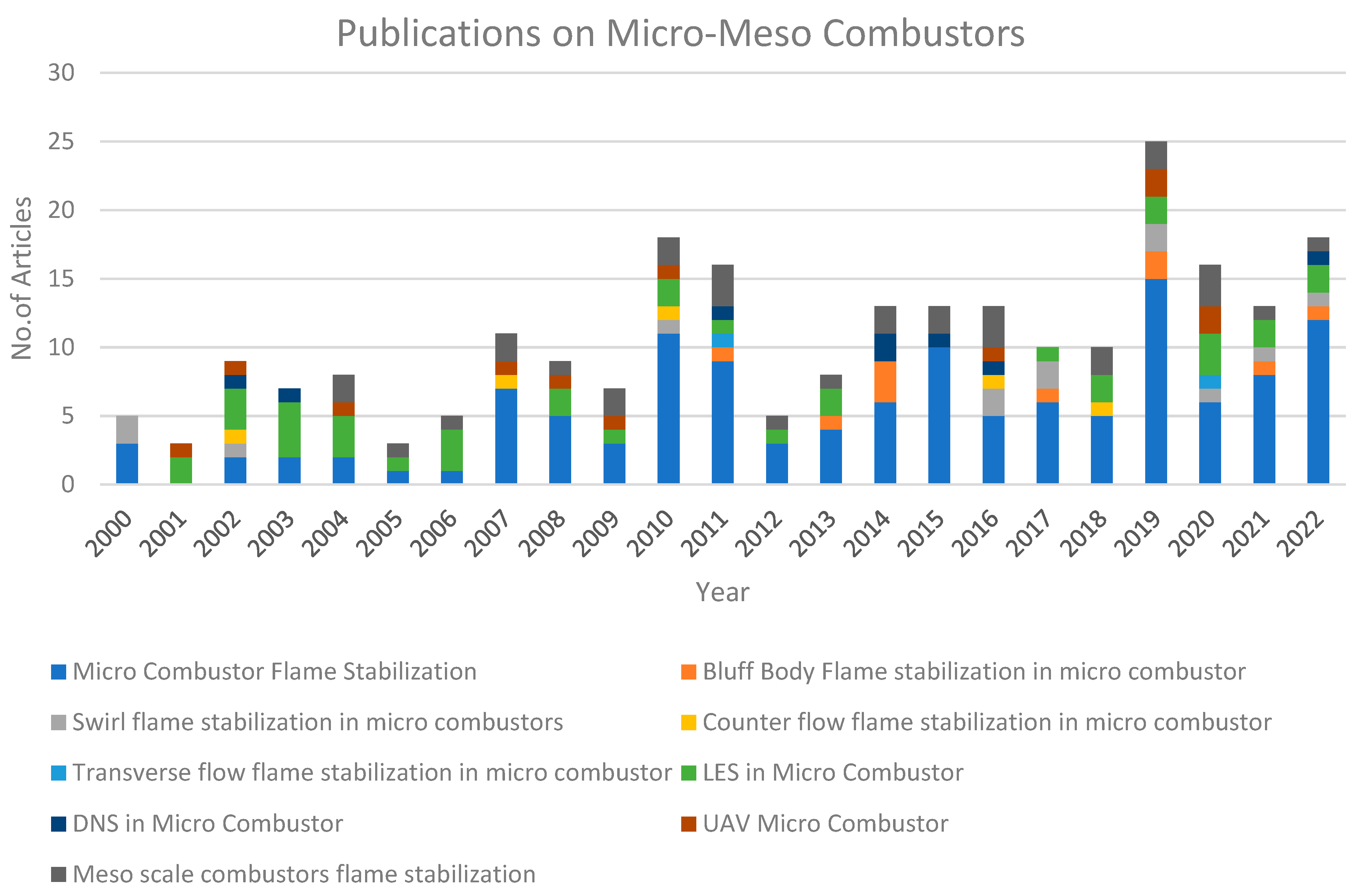
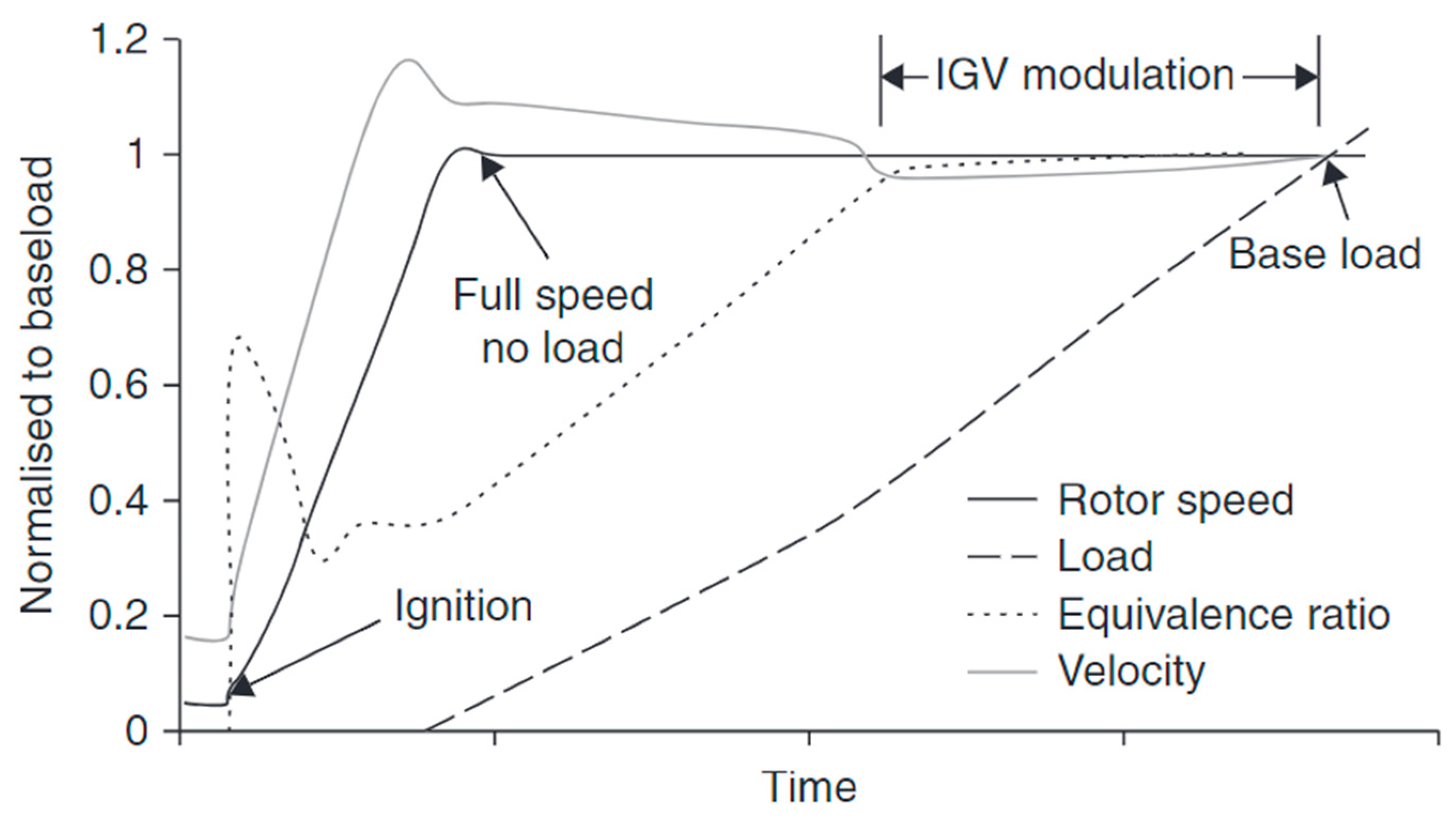
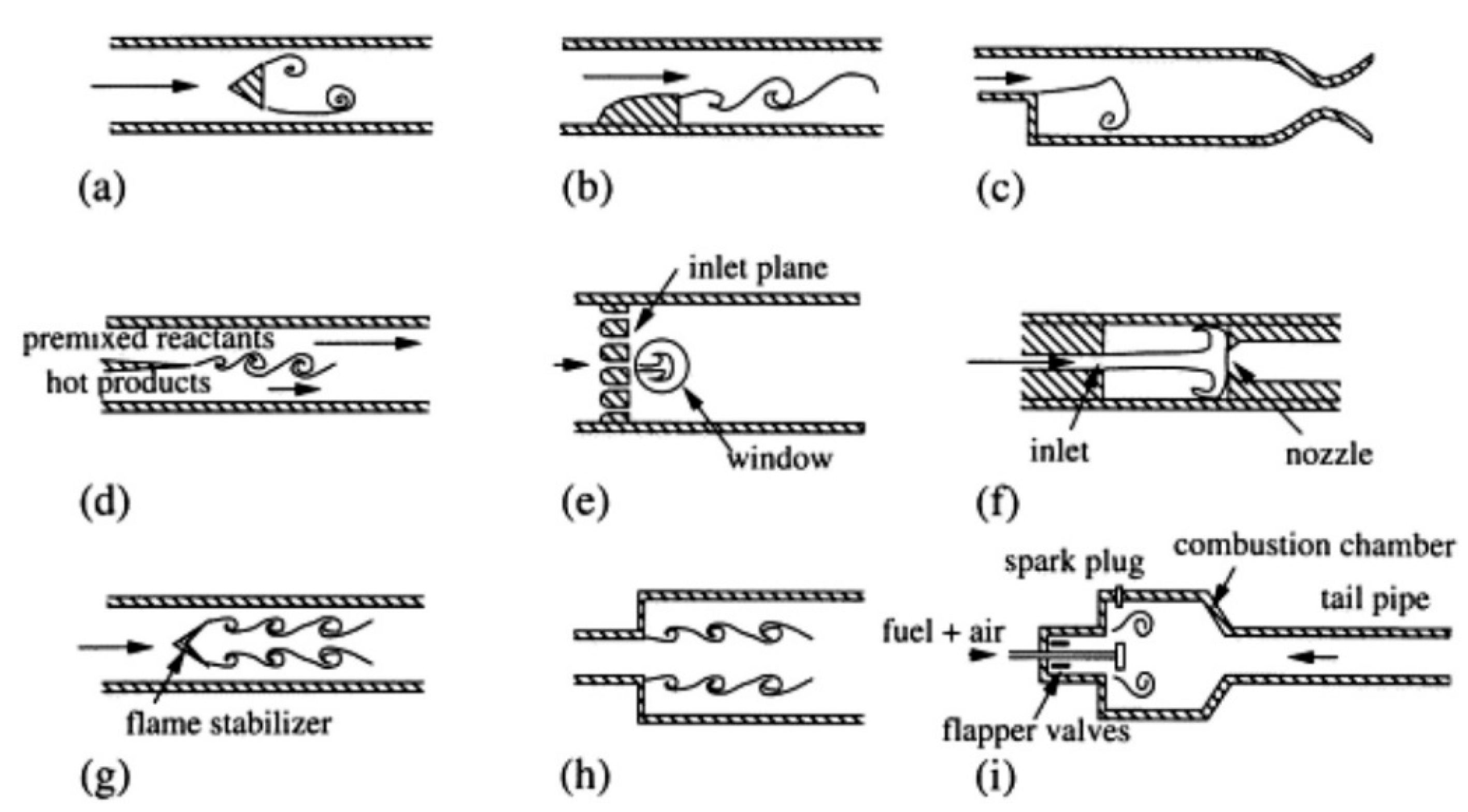
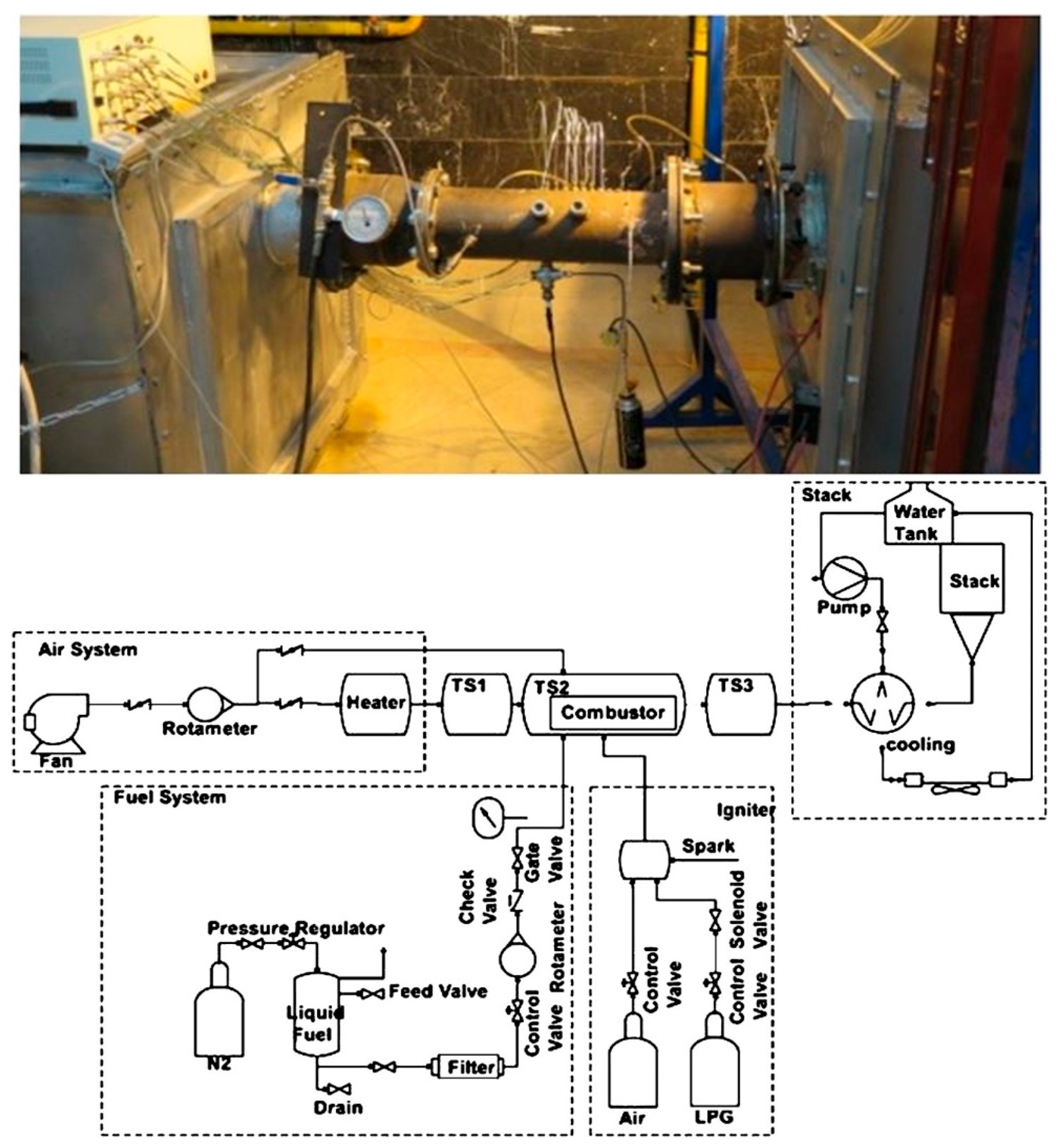


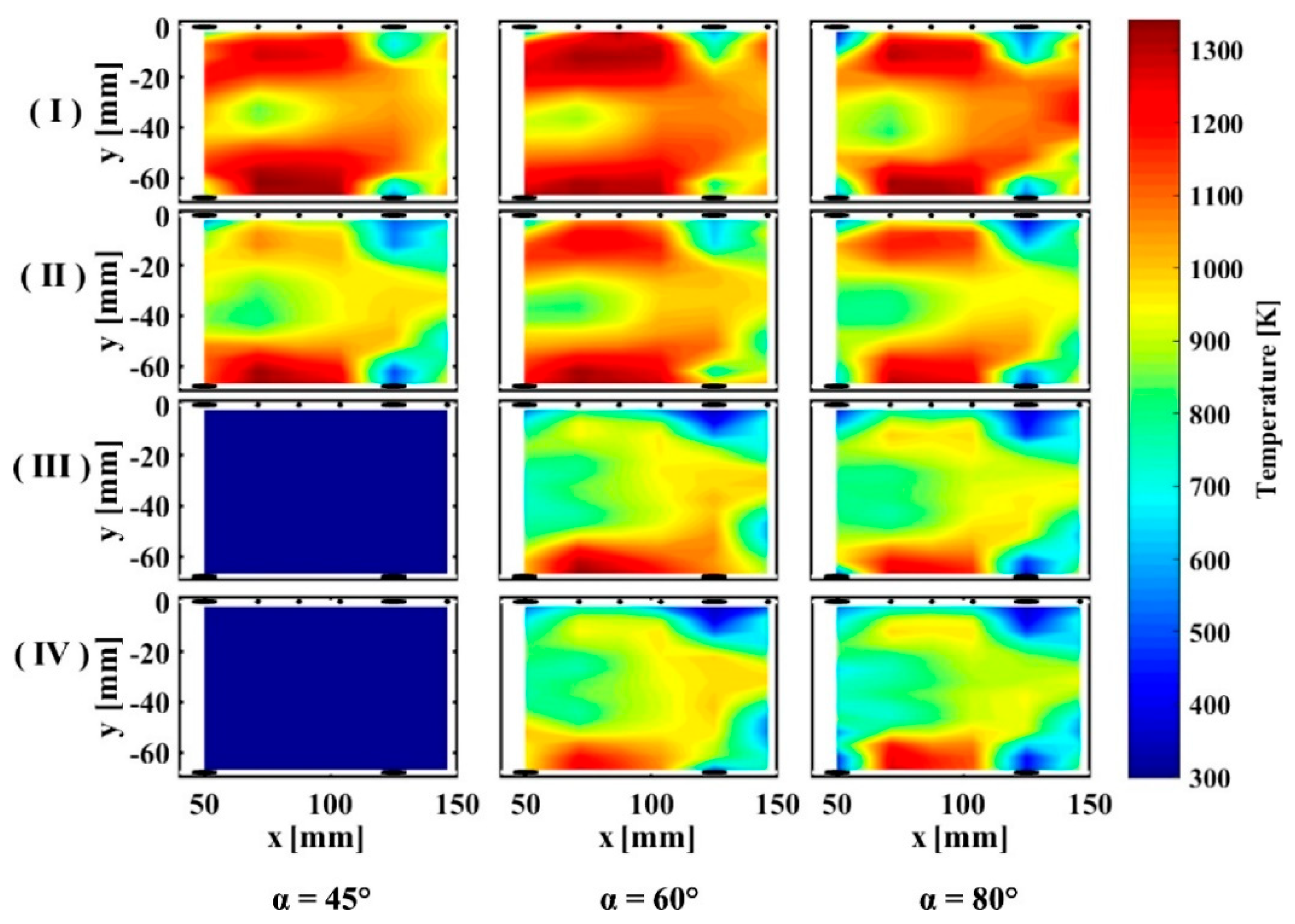
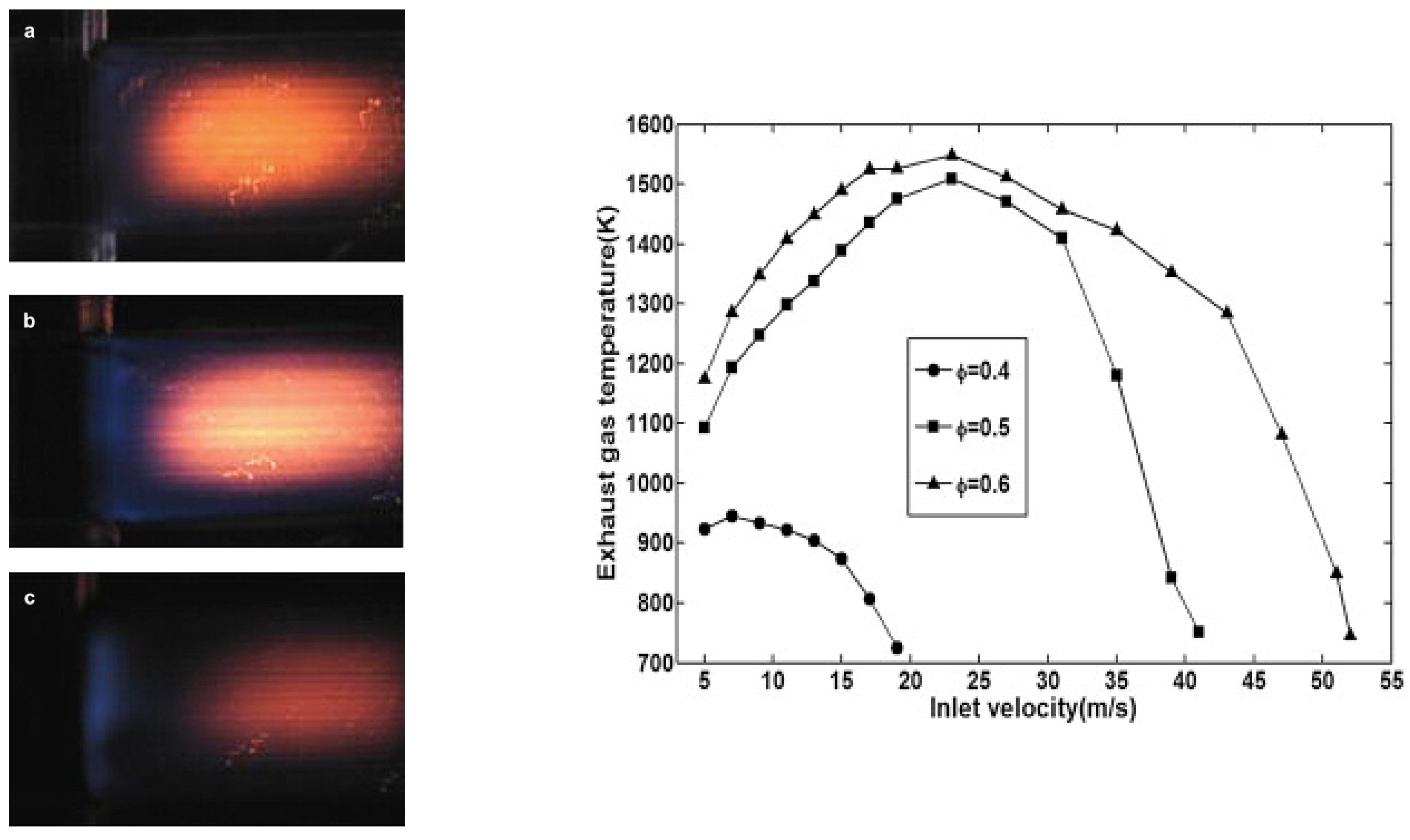
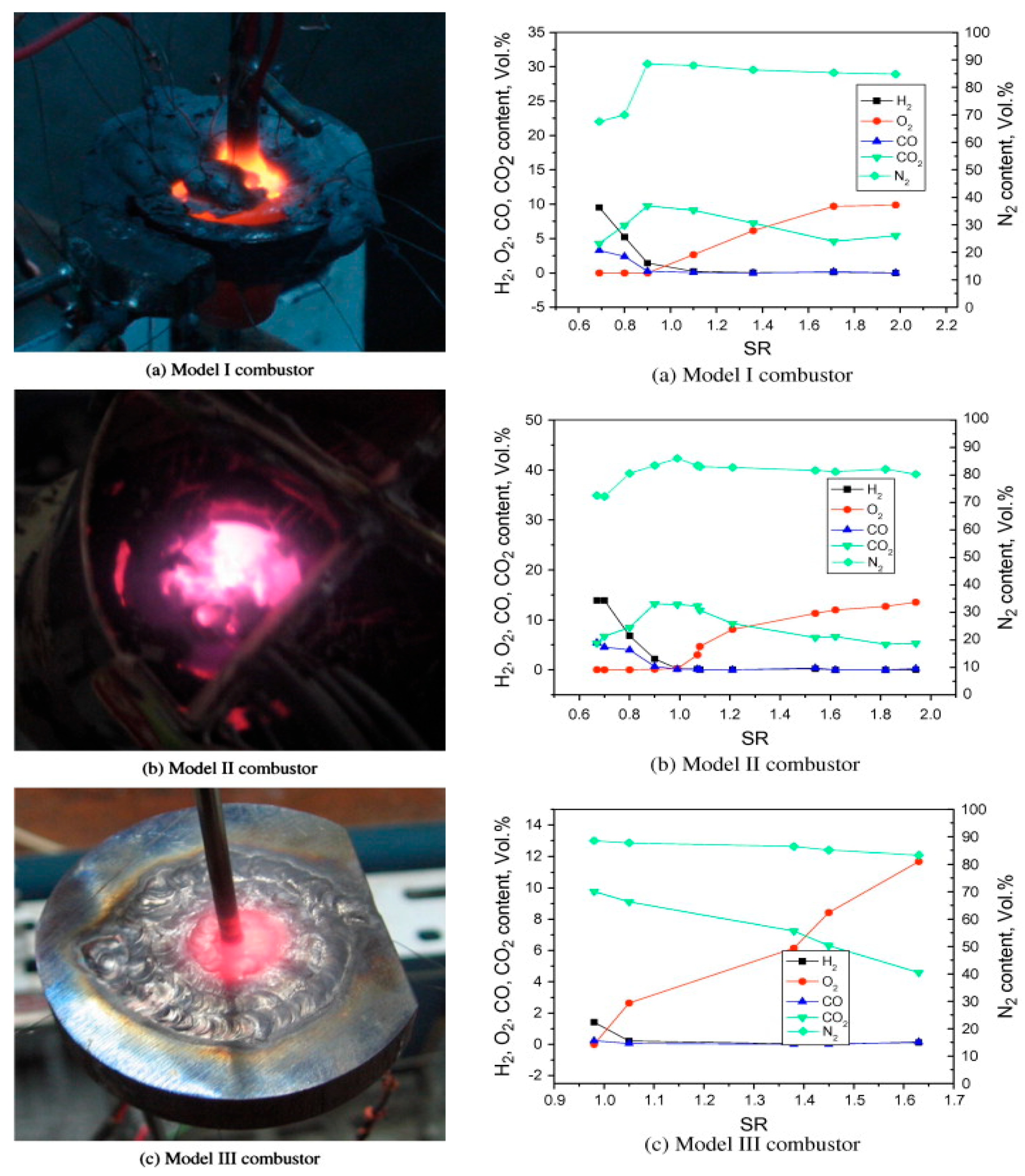

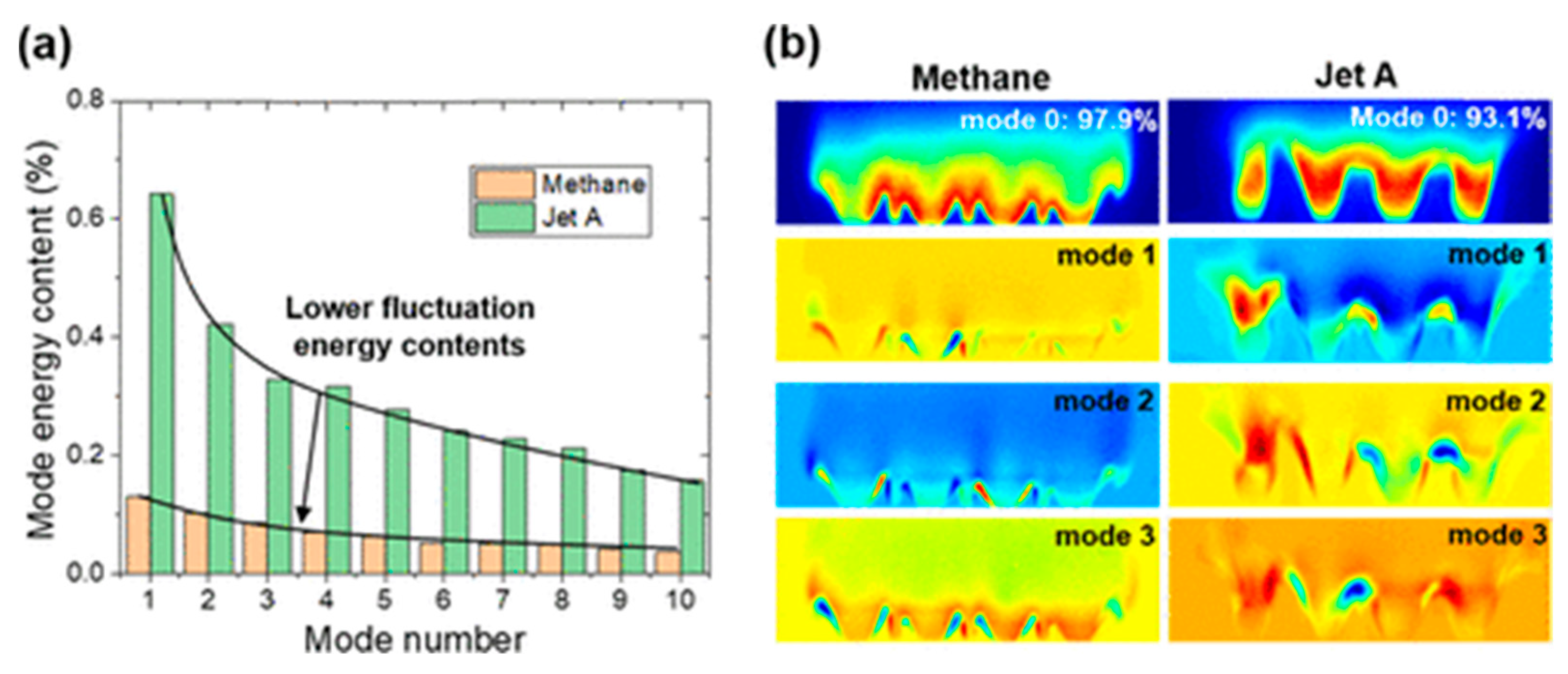
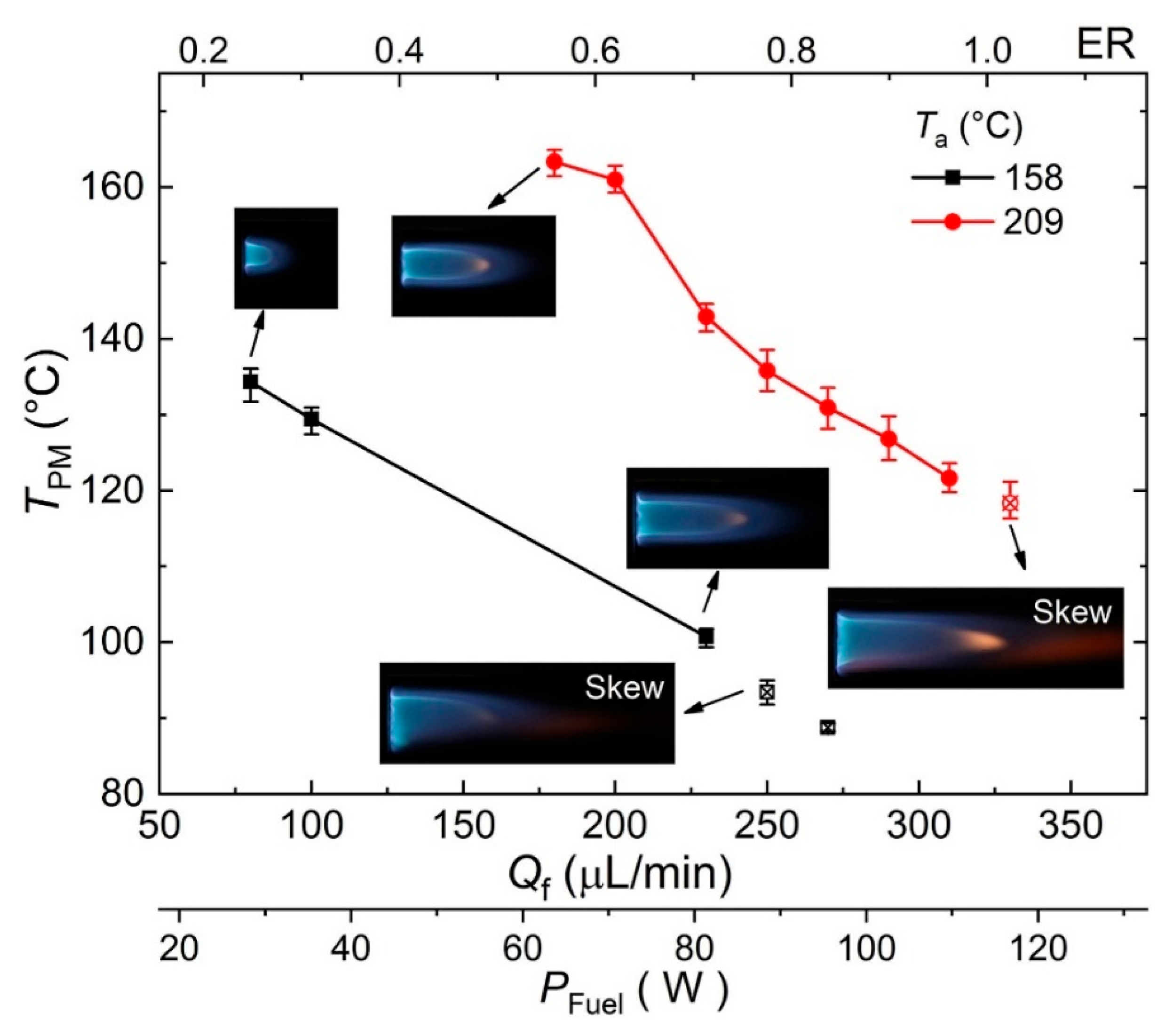
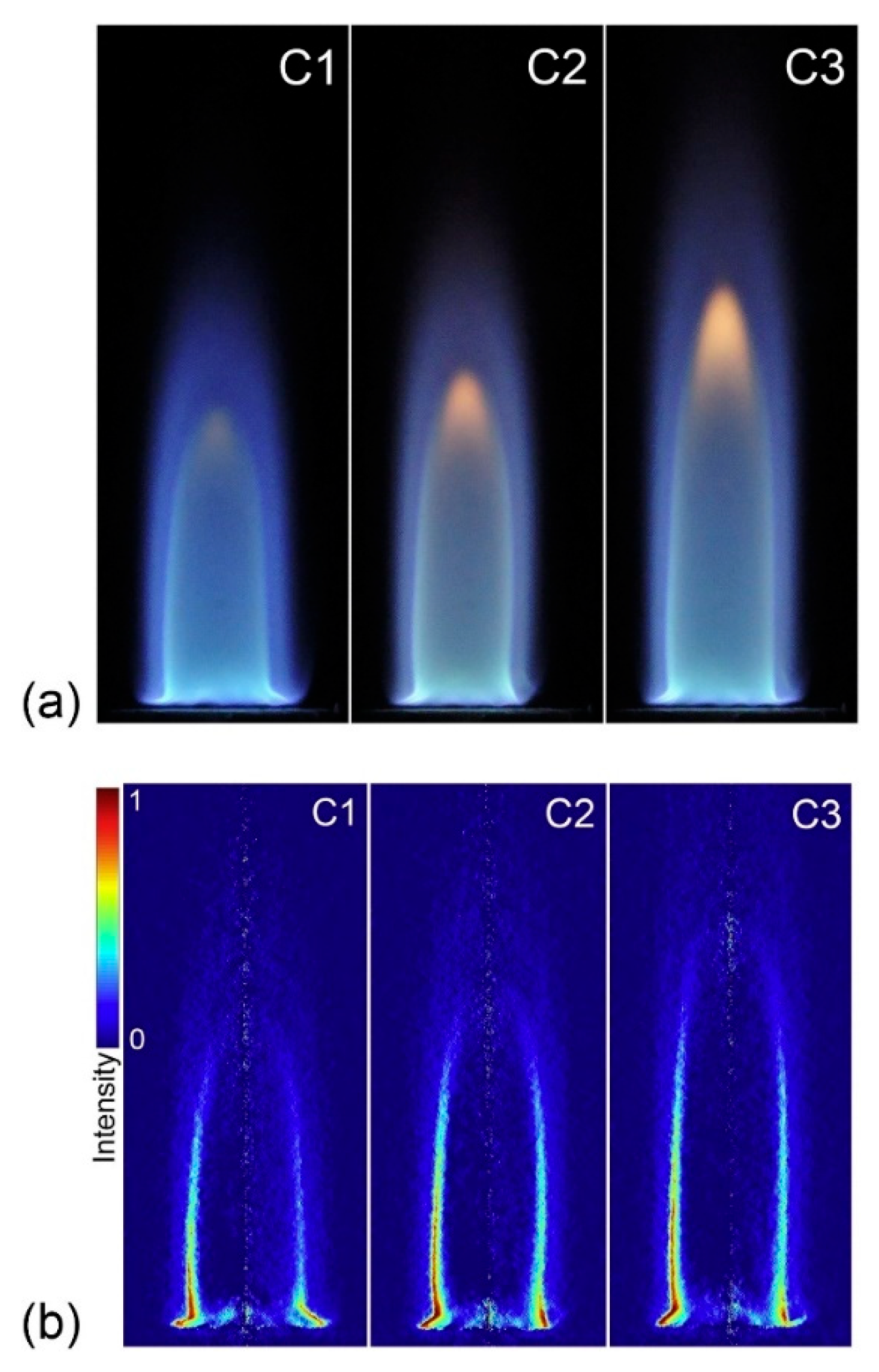
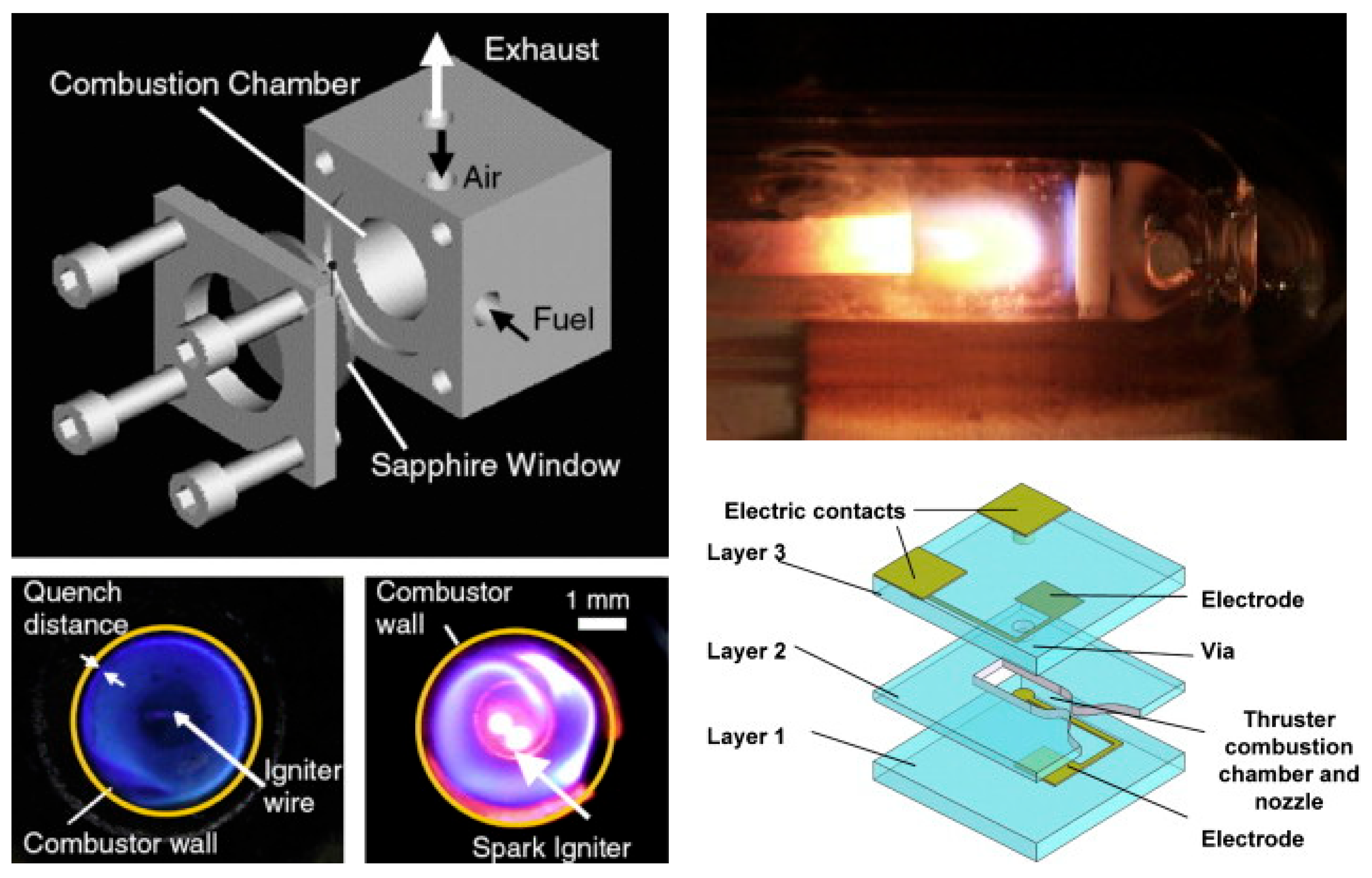
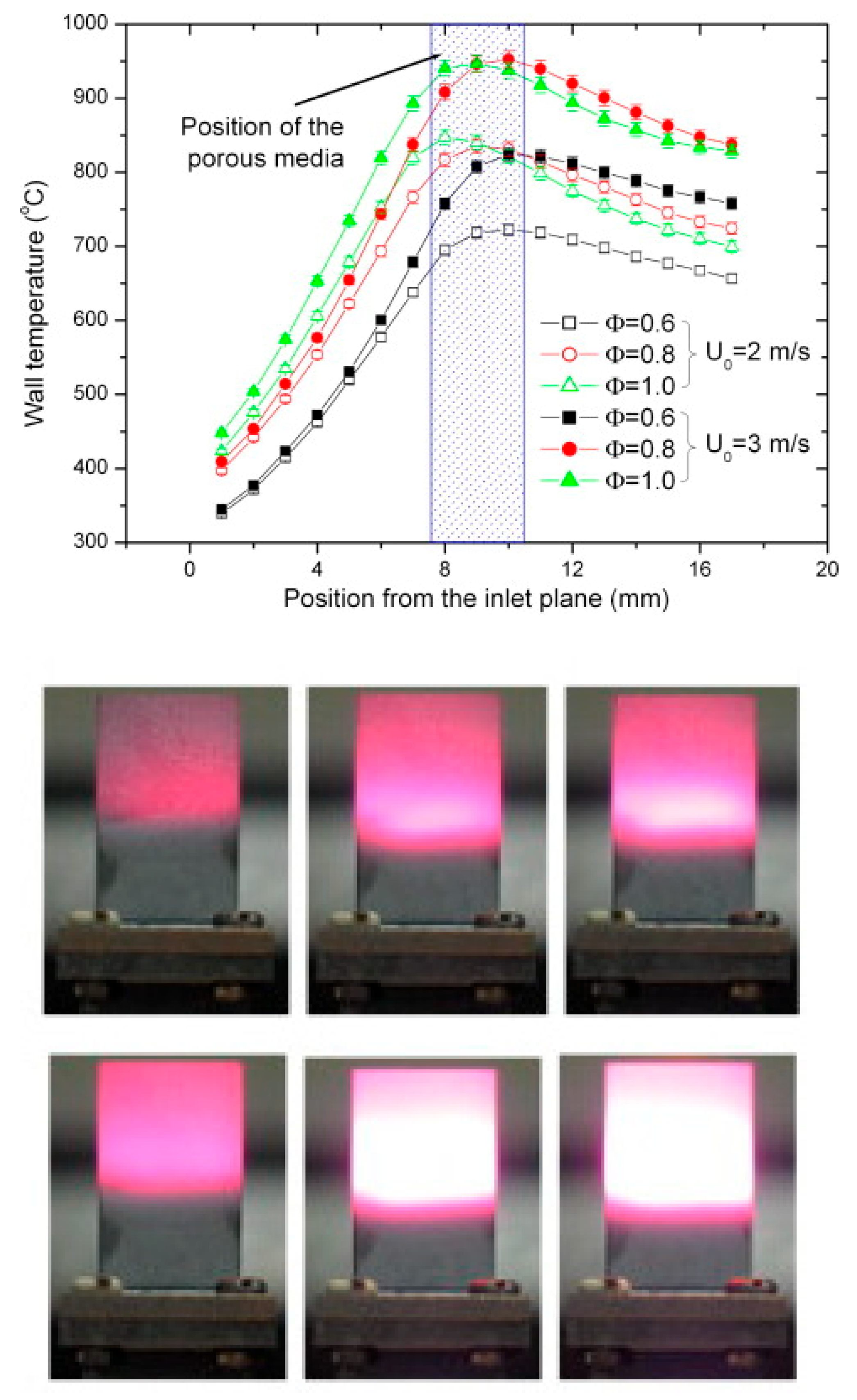
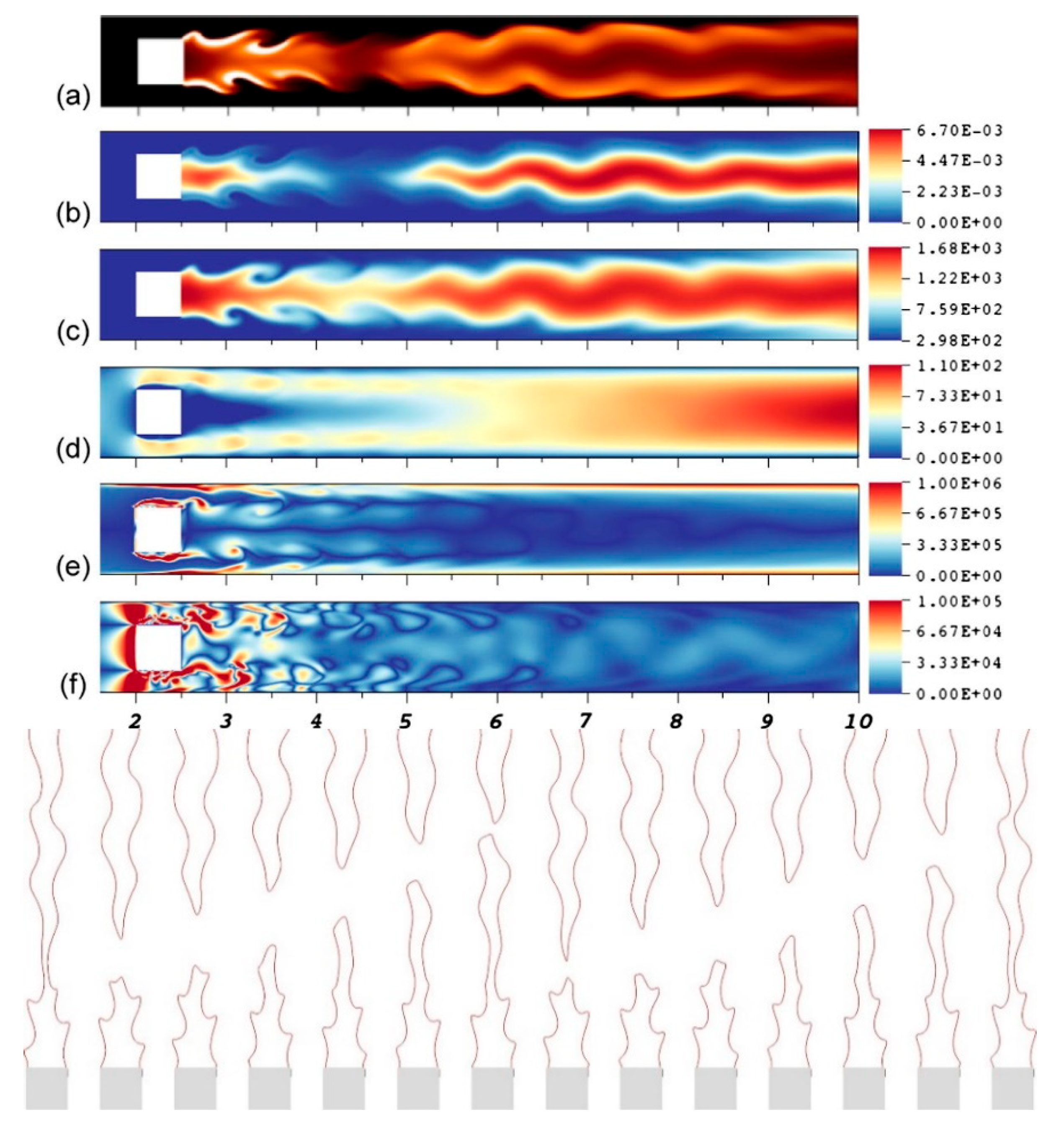


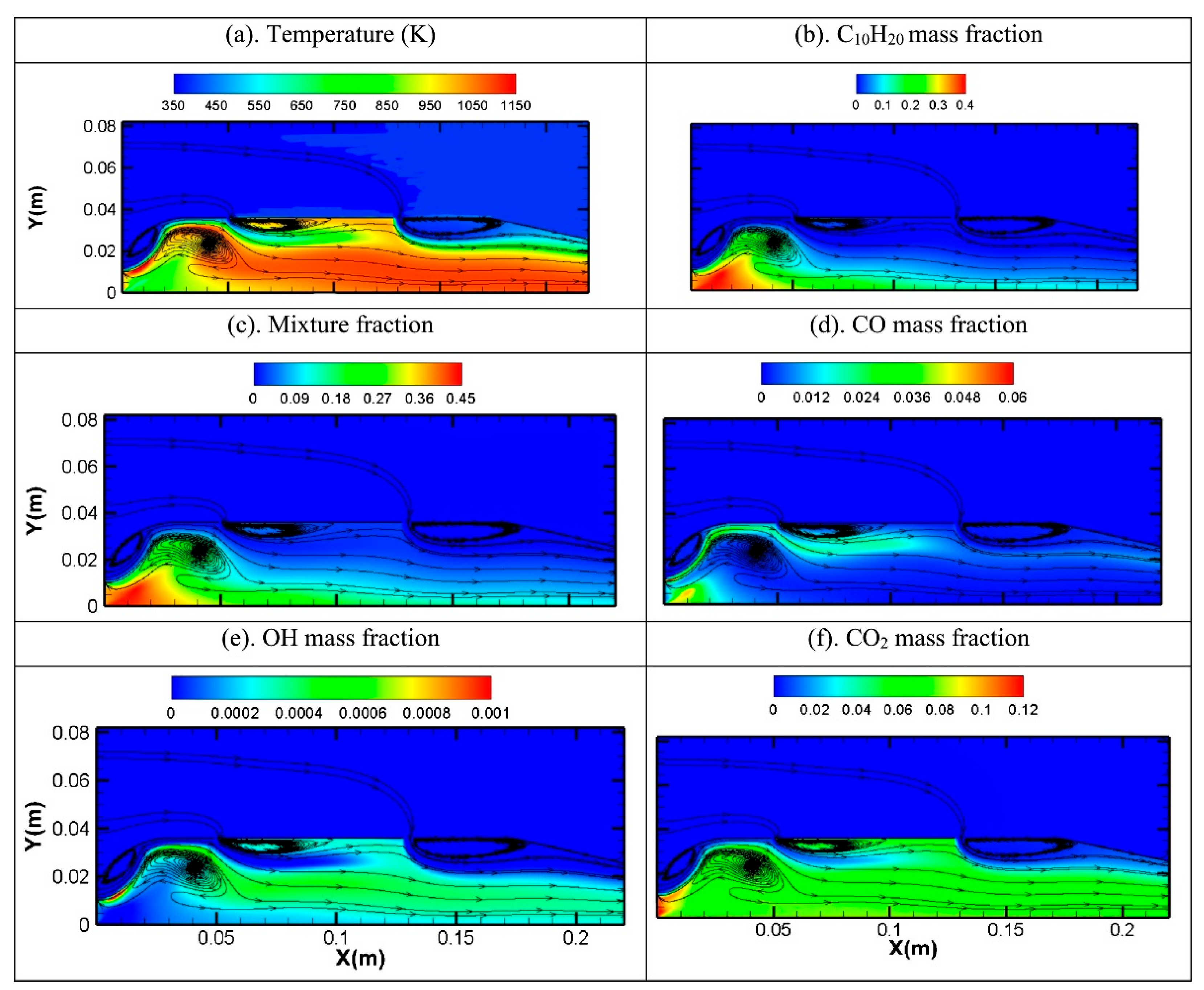
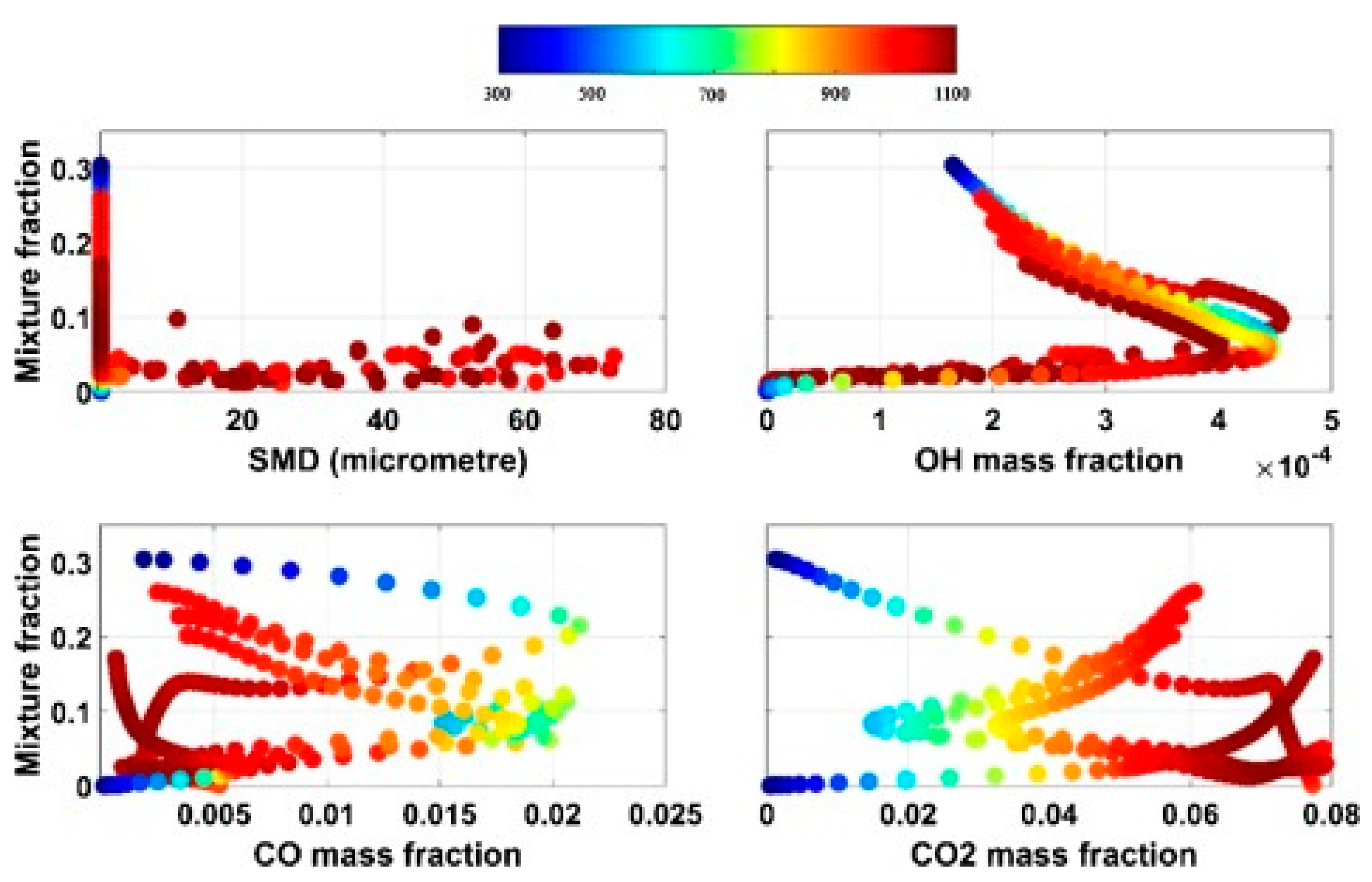
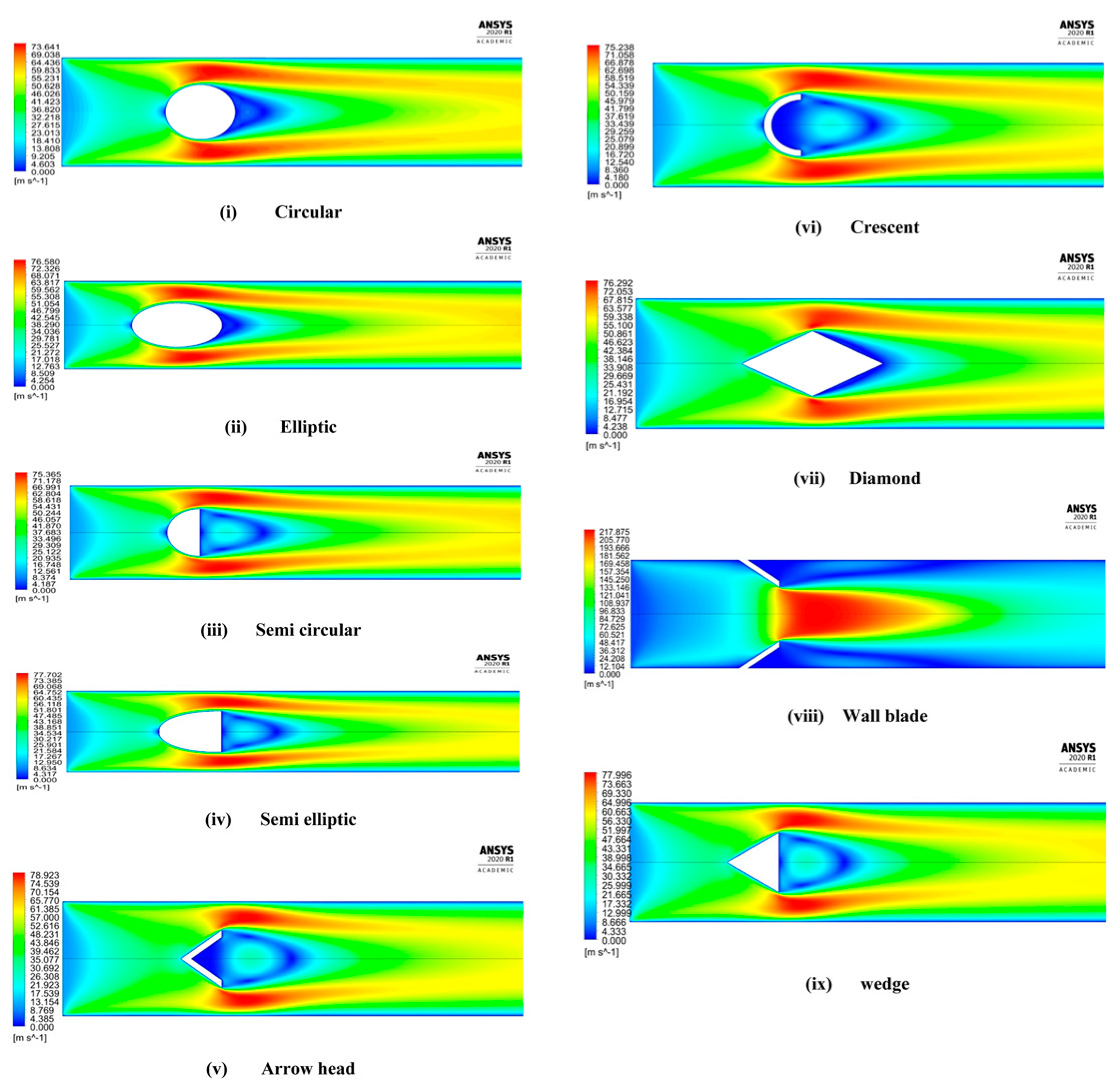
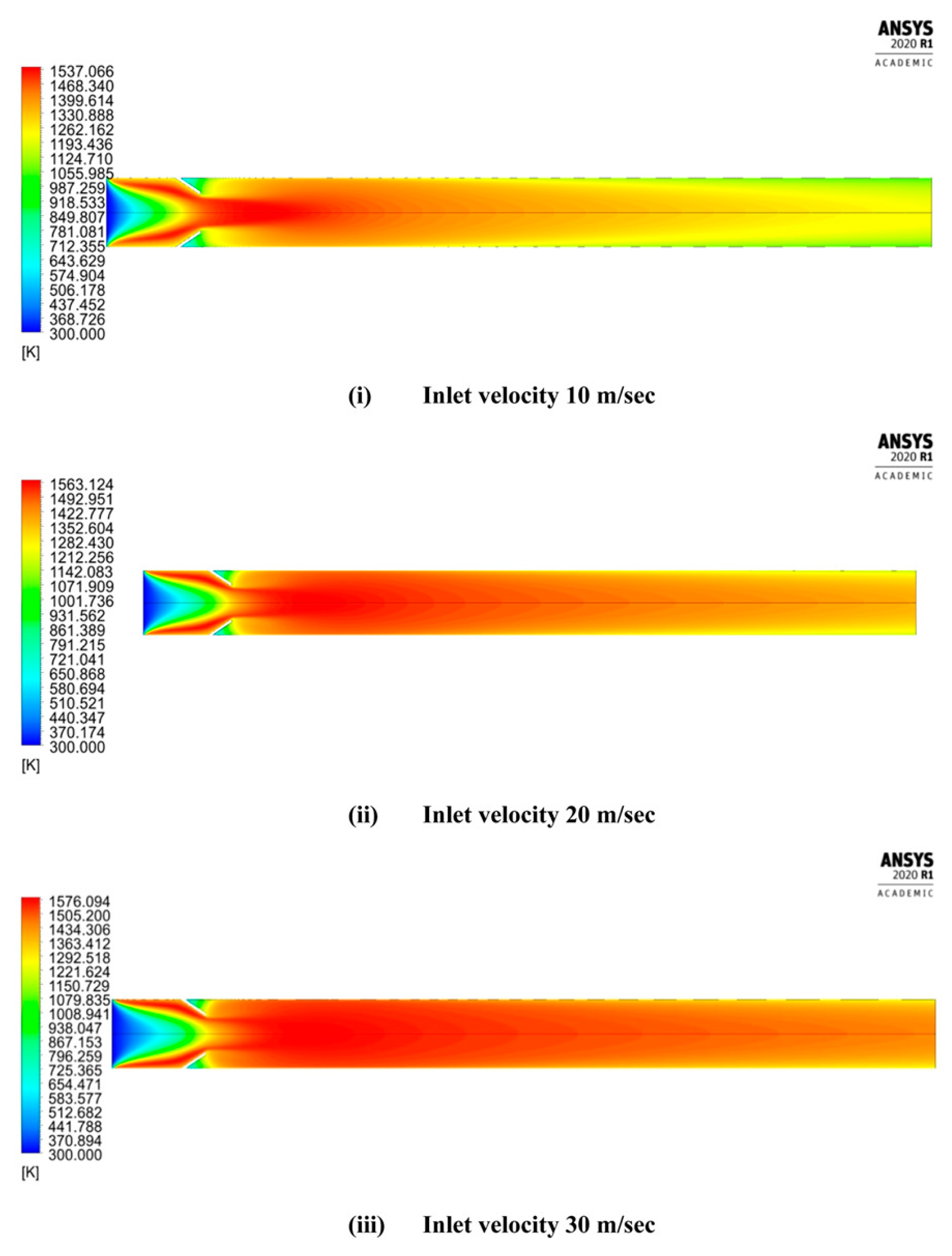
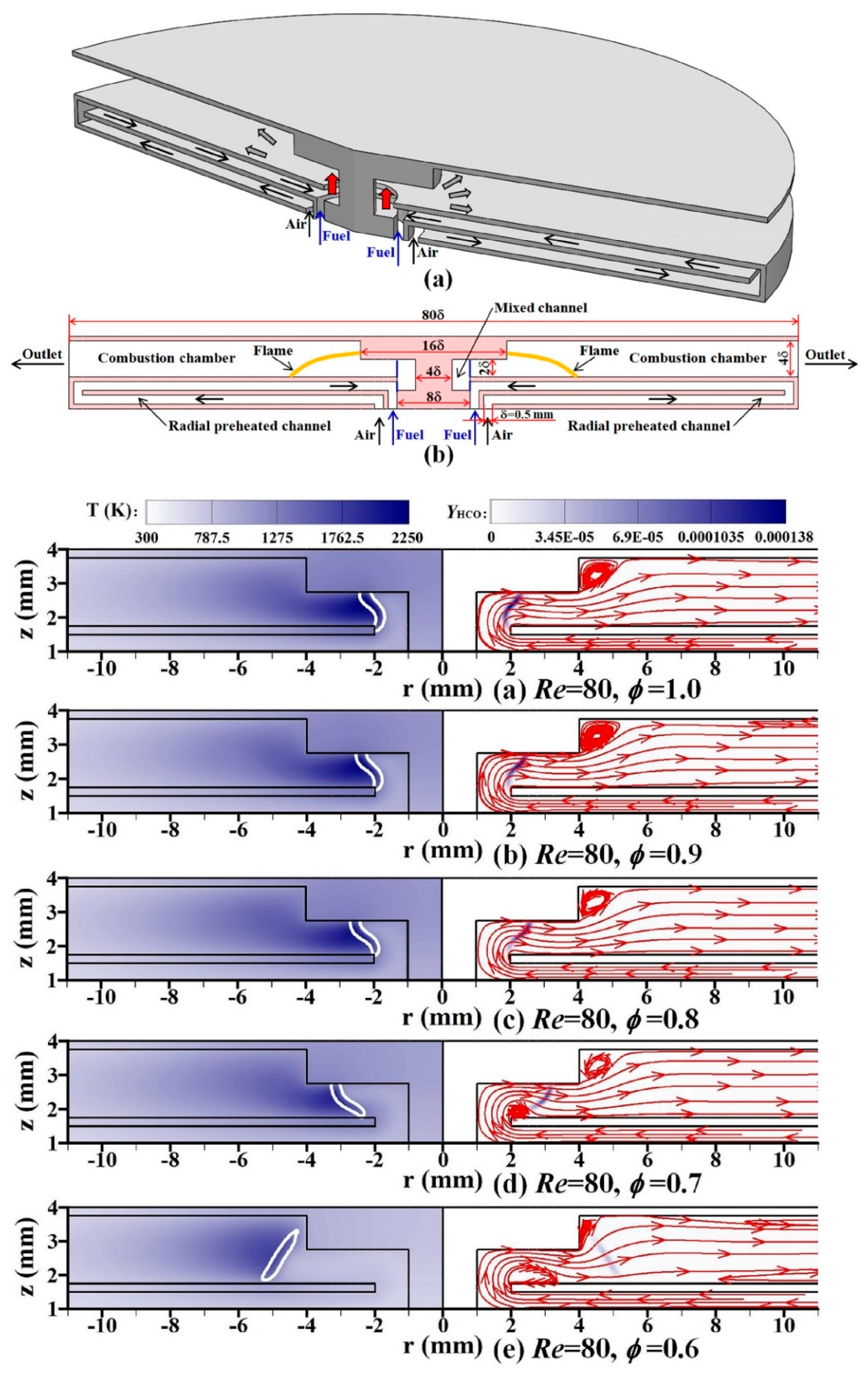
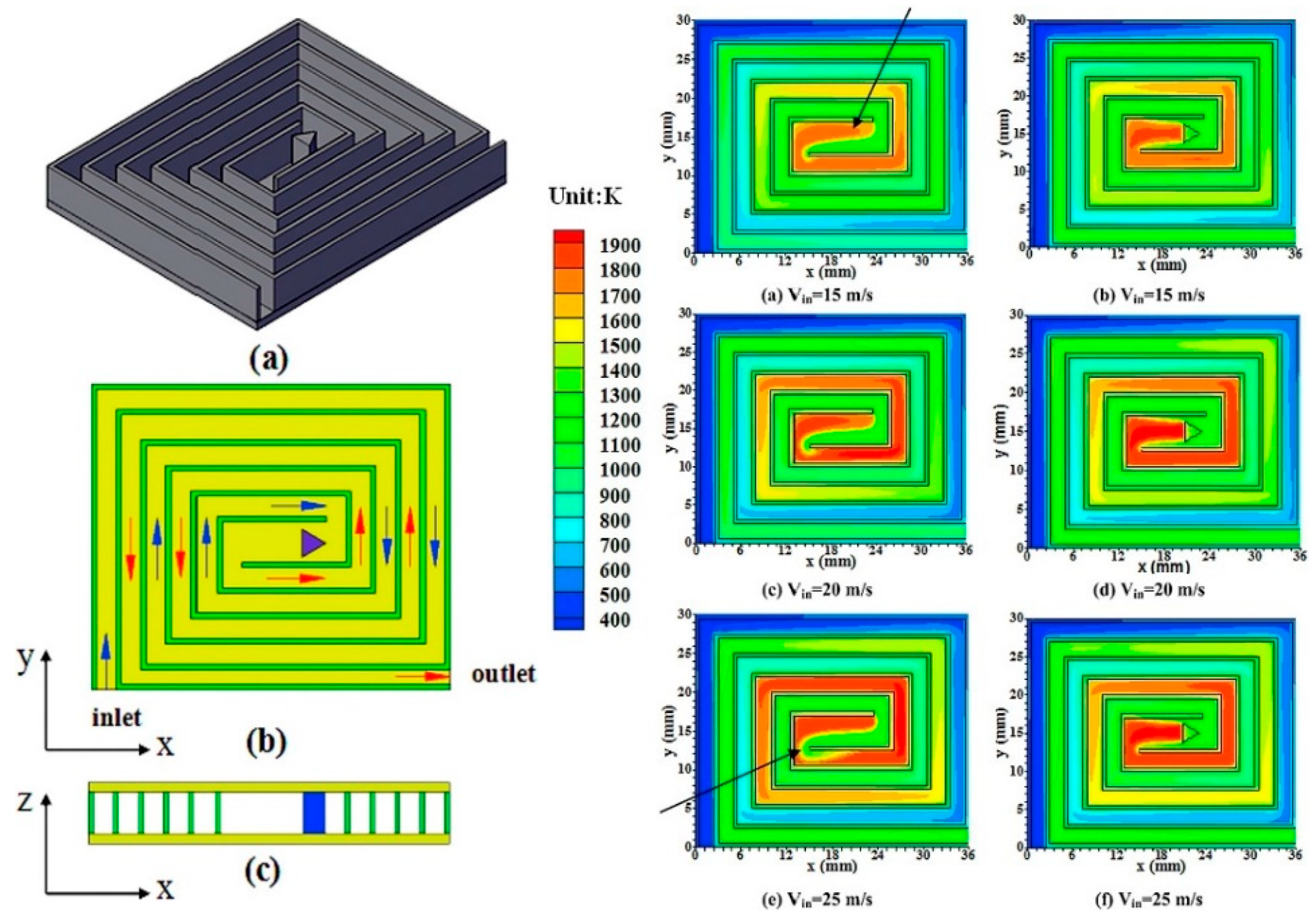
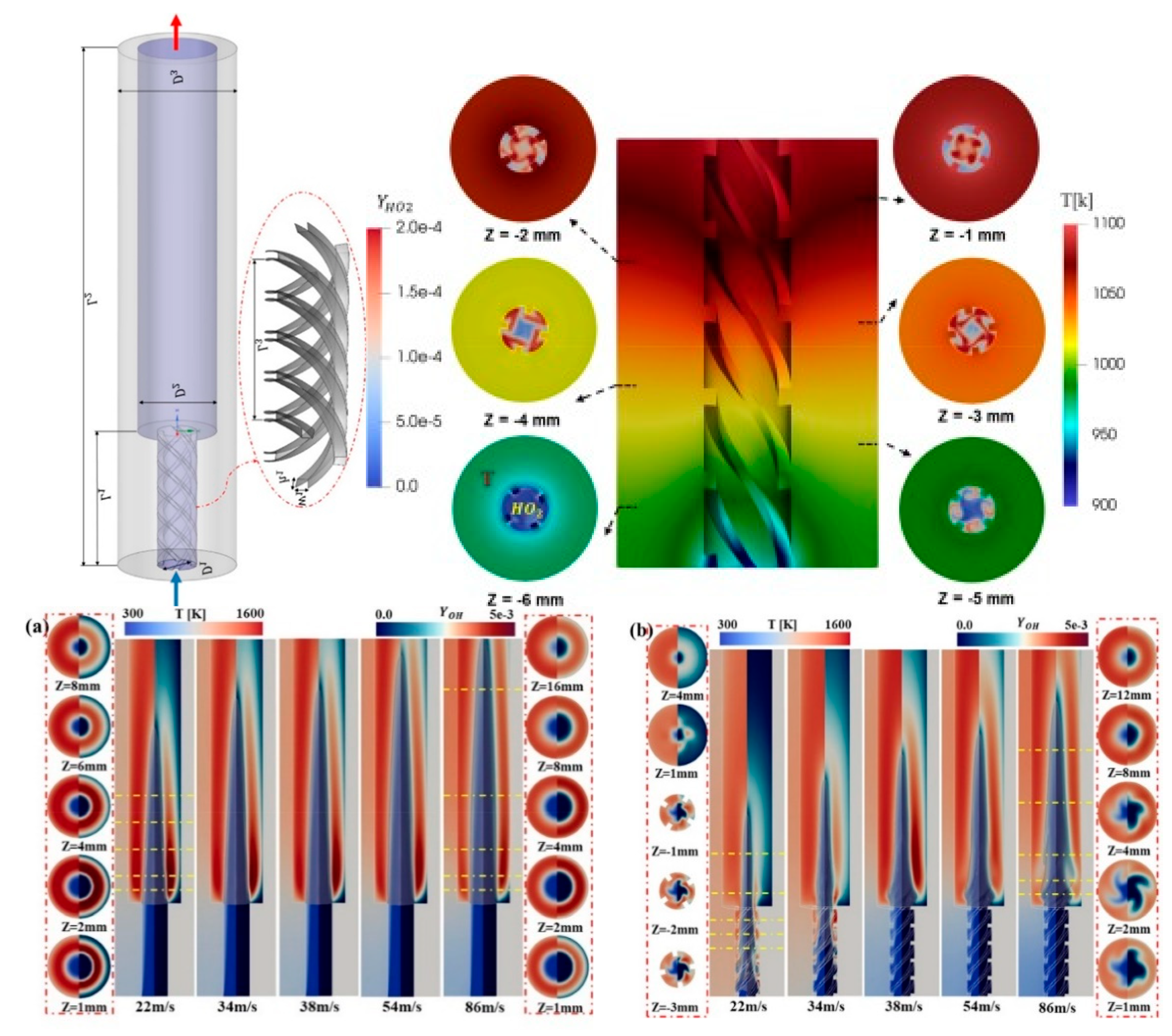
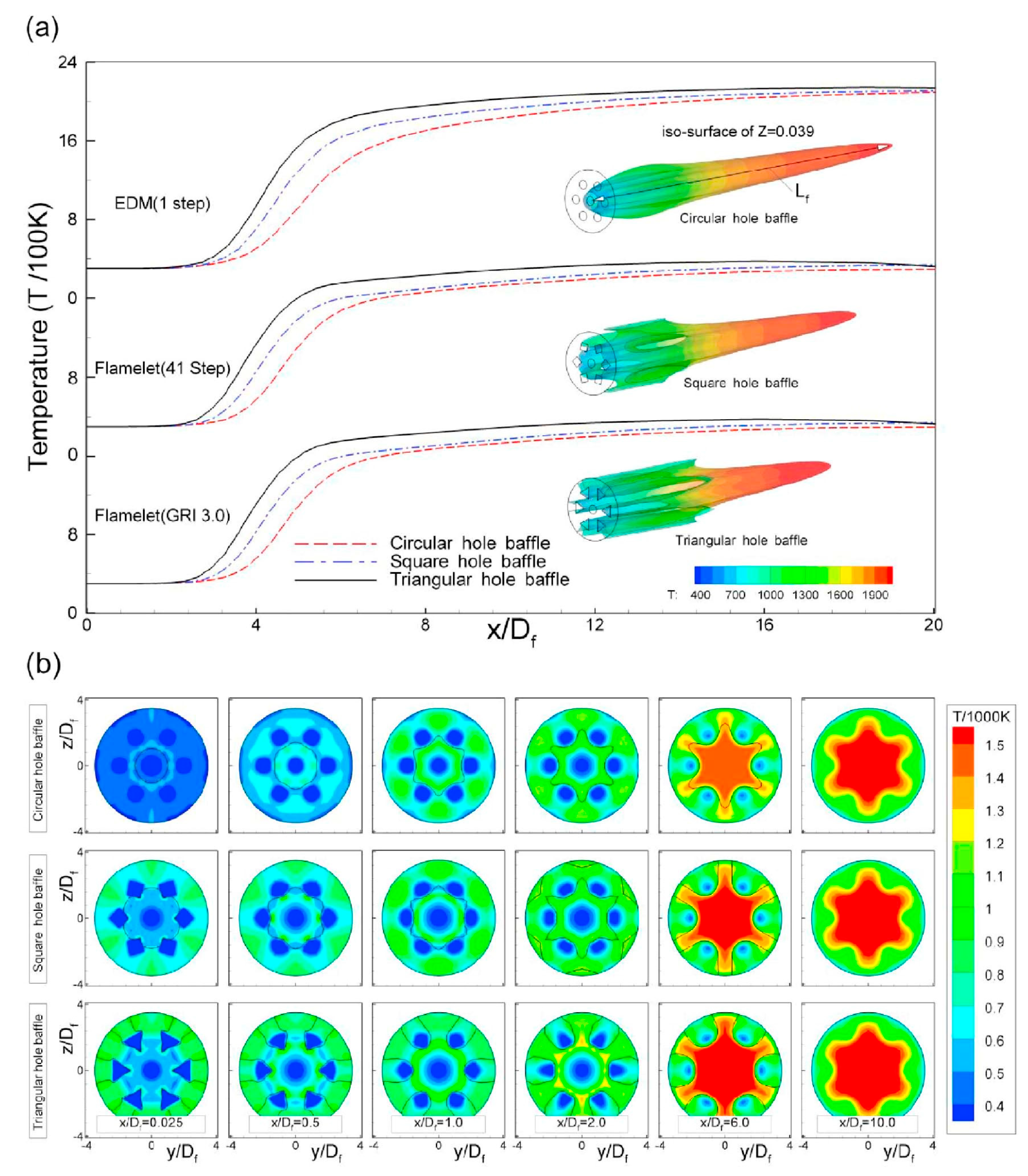

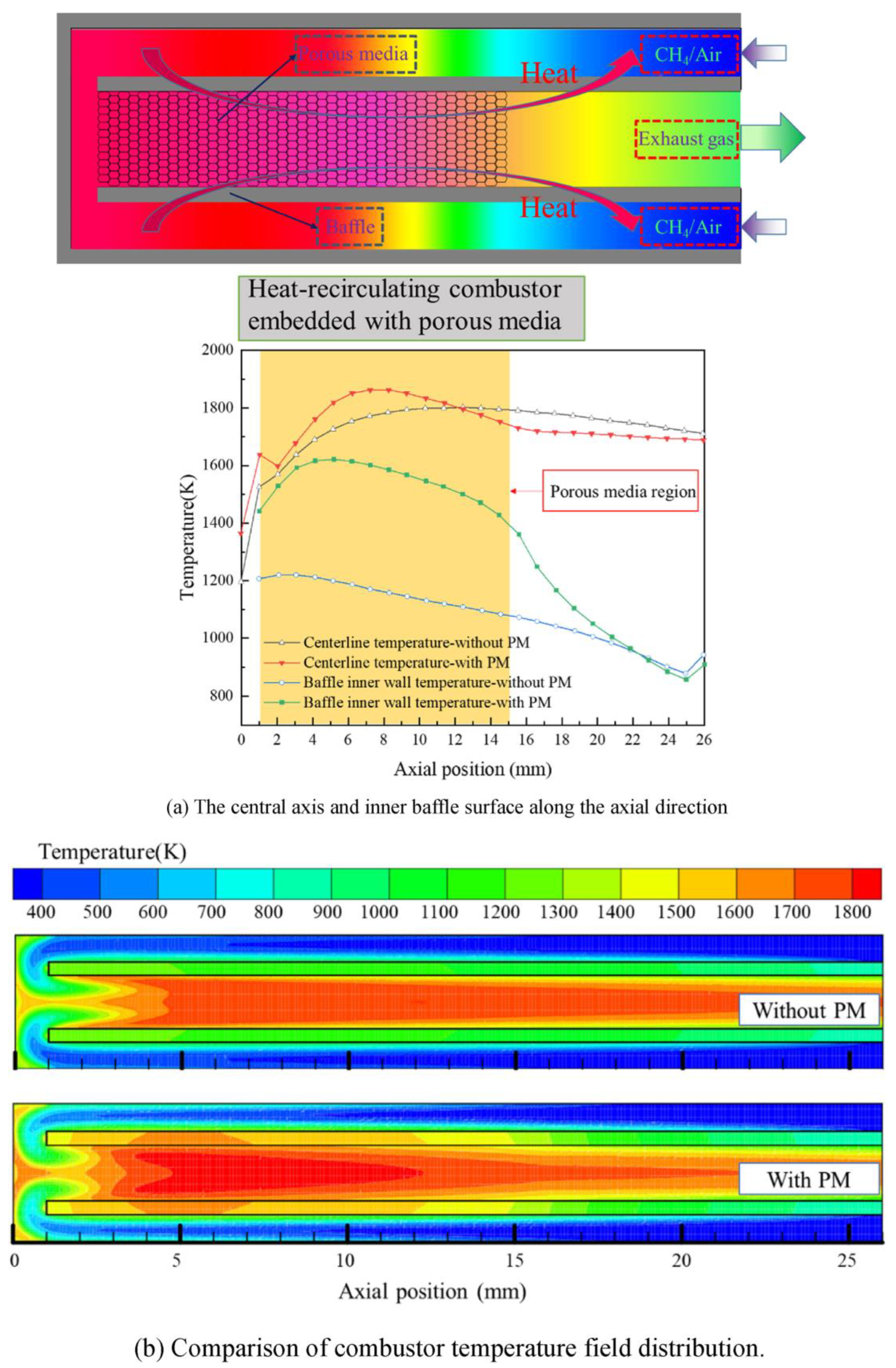
| UAV Category | Maximum Gross Takeoff Weight (MGTW) [lbs] | Size | Airspeed [Knots] | Normal Operating Altitude [ft] |
|---|---|---|---|---|
| Group 1 | 0–20 | Small | <100 | <1200 Above Ground Level |
| Group 2 | 21–55 | Medium | <250 | <3500 |
| Group 3 | <1320 | Large | <250 | <18,000 Mean Sea Level |
| Group 4 | <1320 | Large | Any airspeed | <18,000 Mean Sea Level |
| Group 5 | <1320 | Largest | Any Airspeed | <18,000 |
| UAV/Drone | Engine Type | Fuel * | Endurance [h] | Payload [kg] |
|---|---|---|---|---|
| MQ-1C Gray Eagle | HFE-180HP heavy fuel Engine | Diesel, Jet Fuel | 42 | 227 |
| Mojave | Rolls Royce M250 | JP-4 Aviation Kerosene, Jet fuel | 25+ | 1633 |
| MQ-9 Reaper | Honeywell TPE331-10 | Jet A, A1, JP-1,4,5,8 | 27 | 1361 |
| Predator C Avenger | Pratt & Whitney PW545B turbofan | Jet Fuel | 20 | 2948 |
| Predator XP | Heavily Modified Rotax 914 Turbo | 4-Stroke engine Gasoline | 35 | 147 |
| Global Hawk, Triton, The Embraer 145 | Rolls-Royce AE 3007 Turbofan | JP-8, Jet Fuel | 30 | 910 |
| RQ-7 Shadow 200 | AR741-1101 Single rotor Wankel-type spark ignition engine | Aviation Gasoline | 6 | 25.4 |
| Northrop Grumman X-47C | Pratt & Whitney Canada JT15D-5C High Bypass turbo fan | Jet fuel | 6 | 4500 |
| MQ-8 Fire Scout | Rolls-Royce 250-C20 W | Jet Fuel | 12 | 1338 |
| Harfang | Rotax 914 F | Gasoline, Octane AKI, Octane RON | 26 | 250 |
| Nishant | ALVIS AR-801 | Gasoline | 4.5 | 45 |
| RQ-21 Blackjack | EFI Piston Engine | Gasoline | 16 | 18 |
| RQ-4 Global Hawk | Rolls-Royce AE3007H turbofan engine | Jet Fuel | 36 | 860 |
| CQ-10 Snowgoose | Rotax 914 piston engine | Gasoline | 19 | 227 |
| Scan Eagle | two-blade propeller, Piston engine | Heavy fuel (JP-5 or JP 8) or C-10 gasoline engine | 20–28 | 5 |
| RQ- 5A Hunter | Moto-Guzzi | Gasoline | 30 | 125 |
| Elbit Hermes 450 | UEL R802/R902 (W) Wankel engine | Regular grade Mogas or AVGAS (100LL) | 20 | 180 |
| Watchkeeper | Rotary Wankel water-cooled engine | Aviation Gasoline | 16+ | 150 |
| Kronshtadt Orion | Rotax 914 engine | Gasoline | 24 | 250 |
| CH-4 Chang Hong | Lark HFE unit Wuhu-based Anhui Haery Aviation Power | Heavy Fuel | 30 | 115 |
| Rustom H | NPO-Saturn 36MT engines, Turbo prop | Aviation Gasoline, Jet fuel | 24 | 350 |
| Wing Loong-3 | Turbo Prop Engine | Jet Fuel | 40 | 2300 |
| Sperwer A, B | Bombardier-Rotax 582/562UL | RON 90 Octane, AV Gas 100 LL | 12–24 | 50–100 |
| Bayraktar TB2 | Rotax 912 engines | Gasoline, Octane AKI, Octane RON | 150 |
| Authors | Type of Combustor/Power Source | Industrial Applications | Numerical/Experimental Studies | Key Findings |
|---|---|---|---|---|
| Kentfiled [66] 1998 | Valveless Pulse Jets | UAV, MAV Propulsion applications | SNECMA/Lockwood aero valved design | Thrust augmentation flow rectifier, amplification of the thrust. |
| Fleming et al. [23] 2002 | Small-scale thermoelectric generation | Micro air vehicles, DARPA MAV, | TEG Module testing Integration studies for DARPA | High-temperature TEG Module, Improved thermos electrical efficiency |
| Leach et al. [67] 2005 | Millimeter scale combustor | UAV, MAVs, Missiles | Methane air mixture of two parallel plates, Heat Recirculation with detailed chemistry | Comparison of the heat recirculation and flames with Hydrogen combustors |
| Lloyd et al. [20] Chen et al. [68] Li et al. [21] 2005, 2008 Kim [31] Fan et al. [19] 2017 Wu et al. [69] | Swiss-roll Micro Scale Combustor | Stirling Engine, Micro heat, and Power generation, Cooling applications | Numerical Model developments, Experimental studies, Swiss-roll Catalytic combustor, 3D CFD modelling | Numerical prediction of extension limits, Heat Recirculation studies, combustion efficiency, flame stabilization, blow-off limits, system performance |
| Rideau [70] 2008 | TR60, TR 40 New bypass Turbojet | Missiles, UAVs | Single spool Bypass Turbojet engine | Details about TR60, TR 40 Engine Demonstrator program |
| Minotti et al., Zhang et al. [71,72] 2009, 2022 | Cylindrical Micro Combustor, Helical Fins | Propulsion, Satellite Power systems, UAVs | 3D RANS Eddy dissipation Model, two-step reduced kinetic mechanisms, scaling Laws | Micro Combustor Performance, Numerical Performance of EDC, Framelet model, Micro Step flame-flow Interactions |
| Deshpande et al. [73] 2011 | Backward-facing step Micro combustor | Micro Power Generation, UAVs | Experiment conducted with quartz micro combustors, emission measurements | Effect of geometrical configuration on flame stability limits with two-steps, three-step combustors |
| Wan et al. [2,13,18,19,74,75,76,77,78,79] 2012–2022 | Planner Micro combustor with Bluff body | Combustion based micro power generation and UAVs | 2D RANS, k-e Experiments at 40 m/s with Digital Camera Hydrogen/Air | Blow-off Limits at 0.2, 0.5, 0.6 Equivalence Ratio, Peak Temperature 1850 K |
| Hosseini et al. [80] 2014 | Step Micro flameless combustor with bluff body | Small-Scale Power generation, Micro Thermophotovoltaic, Aviation | 3D RANS, k-e EDC model, Premixed and Non premixed | Combustion efficiency enhanced due to flameless combustion, flame quenching elimination, Higher inlet velocities |
| Catori et al. [81] 2014 | Small-Scale turbojet combustor | UAVs, Drones Gliders | Blast Atomizer Configuration CFD Miniature combustion chamber | Atomization and Mixing characteristics, Exit temperature profiles |
| Zhang et al. [17] 2015 | Hollow hemispherical Bluff body | Power generation, military use aviation, Chemical Industry | 3D with surface catalytic reaction with Deutschman mechanism Methane/air | Hemisphere bluff body enchanted blow-off limits by 2.5 times, tested at stoichiometric conditions |
| Kang et al. [24,25] 2015, 2019 | Mesoscale Combustor with thermally orthotropic wall | Micro Propulsion systems | Parallel plate mesoscale combustor, FLIR systems, Infrared camera | Flammability limits for both pyrolytic graphite and stainless-steel plate Thermal efficiency |
| Lee et al. [16] 2015 | Mesoscale channel with Bluff body | Power generation, Gas turbine combustors | 2D Direct Numerical Simulations (DNS) Hydrogen/air | Detailed visualization of the near blow-off flame characteristics |
| Spytek [82] 2019 | Turboshaft Engine T1310-SA100 | UAV Applications | Multi-inter-turbine burner enabled configuration | Redeveloped configuration with inter-turbine burners, power output |
| Guo et al. [83] 2020 | Swirl/Bluff-body Burner | Power generation, Gas turbine combustors | LES coupled with thickened flame model Particle Image Velocimetry (PIV) Planar Laser Induced Fluorescence (OH-PLIF) Hydrogen enriched CH4/air | Effect of Swirl, Bluff body on hydrogen flame stabilization, Decreased Axial velocity fluctuations, attachment of the flame is weak due to lean mixture. |
| Zou et al. [84] 2020 | Narrow channel with orthotropic walls | Microthrusters, power generation, Propulsion | DNS Studies on bluff-body stabilized flames Premixed Hydrogen/air | Heat loss resistance ability compared with isotropic combustors, Flame structure at higher inlet velocities |
| Sadatakhavi et al., Kankashvar et al. [85,86,87] 2020, 2022 | Can Micro Combustor | Jet engines, UAVs, Micro has turbines | Experimental Studies, RANS Droplet Modelling, Kerosene Liquid fuel, LES studies on oxidant jets | Inner Recirculation zone and Swirl Phenomena along the liner wall, flame formation, droplet breakup, evaporation |
| Choi et al. [26,27] 2021, 2022 | Mesoscale Swirls combustor | UAVs, Burners, Power Generation | Experimental with OH-PLIF Imaging Setup Jet A-Air, Hydrogen rich Fuels | Improve small-scale flame stability, reduce length scales, overall combustion characteristics, Lean Blow-off limits |
| Ghali et al. [88] 2021 | Micromix Combustor | Auxiliary Power Units, Propulsion | Eddy Dissipation Model with single injection Hydrogen air | Lean mixture and influence of equivalence ratio and NOx formations |
| Khan et al., Zizin et al. [89,90] 2015, 2022 | Micro combustor with an embedded passive fuel pumping | Micro Aerial vehicles, Power Generation | Non-Premixed Ethanol combustion, flame fluctuations | Atomization at ultra-low flow rates, Heat loss from the combustors |
Disclaimer/Publisher’s Note: The statements, opinions and data contained in all publications are solely those of the individual author(s) and contributor(s) and not of MDPI and/or the editor(s). MDPI and/or the editor(s) disclaim responsibility for any injury to people or property resulting from any ideas, methods, instructions or products referred to in the content. |
© 2023 by the authors. Licensee MDPI, Basel, Switzerland. This article is an open access article distributed under the terms and conditions of the Creative Commons Attribution (CC BY) license (https://creativecommons.org/licenses/by/4.0/).
Share and Cite
Velidi, G.; Yoo, C.S. A Review on Flame Stabilization Technologies for UAV Engine Micro-Meso Scale Combustors: Progress and Challenges. Energies 2023, 16, 3968. https://doi.org/10.3390/en16093968
Velidi G, Yoo CS. A Review on Flame Stabilization Technologies for UAV Engine Micro-Meso Scale Combustors: Progress and Challenges. Energies. 2023; 16(9):3968. https://doi.org/10.3390/en16093968
Chicago/Turabian StyleVelidi, Gurunadh, and Chun Sang Yoo. 2023. "A Review on Flame Stabilization Technologies for UAV Engine Micro-Meso Scale Combustors: Progress and Challenges" Energies 16, no. 9: 3968. https://doi.org/10.3390/en16093968
APA StyleVelidi, G., & Yoo, C. S. (2023). A Review on Flame Stabilization Technologies for UAV Engine Micro-Meso Scale Combustors: Progress and Challenges. Energies, 16(9), 3968. https://doi.org/10.3390/en16093968







